Two religious orders are relocating to East Tennessee from Italy
 By Bill Brewer
By Bill Brewer
The Diocese of Knoxville welcomed two new religious communities to East Tennessee on the feast of Our Lady of Guadalupe as the Benedictines of Divine Will and the Benedictine Daughters of Divine Will formally announced they are relocating from Italy to Blount County.
Both religious orders are contemplative communities; however, they are not cloistered. They were erected in the Diocese of San Marino-Montefeltro a decade ago in concert with their devotion to Servant of God Luisa Piccarreta of Corato, Italy, whose cause for sainthood is under study by the Vatican as are her widely followed Divine Will writings.
Father Elijah John Joseph of Our Lady of Guadalupe, who leads the Benedictines of Divine Will, and Mother Gabrielle Marie Breaux, mother superior and foundress of the Benedictine Daughters of Divine Will, were present for the decree-signing ceremony held on Dec. 12 in the Our Lady of the Mountains Chapel at the Diocese of Knoxville Chancery.
The decrees formally establish the public associations of the faithful in the Diocese of Knoxville.
Bishop Richard F. Stika helped lead the effort to transplant the Benedictine orders near Maryville after the orders had sought guidance on possibly relocating to the United States, where they felt developing vocations would be more productive.
Signatories on the decrees were Bishop Stika, Deacon Sean Smith, who is the Diocese of Knoxville chancellor, Father Elijah, and Mother Gabrielle Marie. The decrees also received the signature of the bishop of the Diocese of San Marino-Montefeltro in Italy, Monsignor Andrea Turazzi, who was not in attendance. Cardinal Justin Rigali was on hand as the documents were signed.
The documents recognized that on April 12, 2011, Monsignor Luigi Negri, then the bishop of the Diocese of San Marino-Montefeltro, erected the Benedictine Daughters of Divine Will as a public association of the faithful.
Then on Sept. 25, 2012, Dec. 31, 2013, March 19, 2015, March 19, 2018, and Feb. 25, 2021, Monsignor Turazzi, the current bishop of the Diocese of San Marino-Montefeltro, renewed and confirmed the Benedictine Daughters of Divine Will.
On Dec. 20, 2014, Bishop Turazzi erected the Benedictines of Divine Will as a public associa -
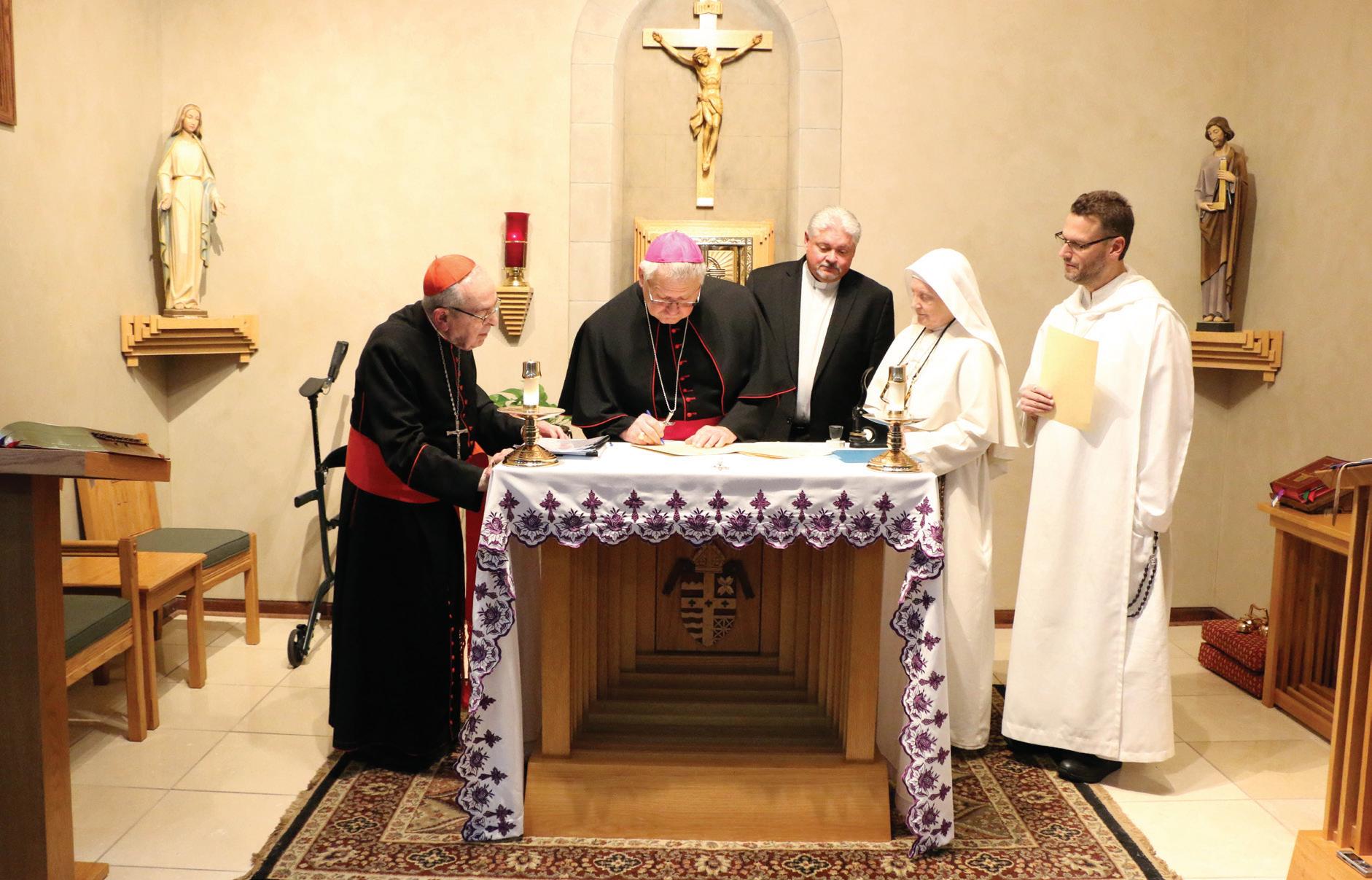 By The East Tennessee Catholic
By The East Tennessee Catholic
The Diocese of Knoxville has announced that the McNabb Center, the region’s leading nonprofit provider of mental health, substance use, and social and victim services, will serve as the diocese’s new sexual assault victim’s reporting provider, the first point of contact for anyone wishing to report a possible sexual abuse claim against the diocese.
“This is a positive step for our diocese, but most important it is a new path forward for anyone who feels that they have been a victim of abuse,” said Bishop Richard F. Stika. “We are pleased and grate-
Bishop Richard F. Stika
tion of the faithful. Then on Oct. 1 of this year, he renewed and confirmed the men’s religious order.
The decrees go on to state that the Benedictine Daughters and the Benedictines formally petition the bishops of San Marino-Montefeltro and Knoxville in writing their desire to transfer their motherhouses and public associations of the faithful from the Diocese of San MarinoMontefeltro to the Diocese of Knoxville “with the complete understanding that this would include the transfer of competent ecclesiastical authority of the public associations from Bishop Turazzi to Bishop Stika.”
Bishop Turazzi and Bishop Stika communi -
Center partner on sexual assault
ful that the McNabb Center has agreed to take on this vital role as an independent third-party agency.”
The agreement between the diocese and the McNabb Center was announced after several months of detailed discussion.
“Sexual abuse is often difficult to talk about, and we want to encourage individuals to report and receive support and assistance,” said Catherine Oaks, who is the director of victim services for the McNabb Center.
“Calls from the reporting line will be responded to compassionately by a master’s level clinician uniquely experienced and trained
within our victim services division of McNabb.”
This partnership with McNabb and the Diocese of Knoxville will provide an independent avenue for individuals to report sexual abuse and receive information on how and where to access support and treatment as needed.
In the Diocese of Knoxville, the coordinator maintains a vital role in making sure any abuse victim is treated with dignity and respect, and the coordinator will follow all mandatory reporting laws.
The diocese’s previous victim’s assistance coordinator, Marla Lenihan, a licensed mental health therapist from Oak Ridge, served
in that position for 20 years. Ms. Lenihan died in March following a battle with cancer.
Father Doug Owens, pastor of All Saints Parish in Knoxville and a vicar general of the Diocese of Knoxville, served as the interim coordinator while the new agreement was being developed.
“Marla did a remarkable job for our diocese for two decades. She was compassionate and had a great understanding of the challenges faced by abuse victims. We are indebted to her service,” Bishop Stika said.
“It is unique to partner with an independent outside agency, but
“This is truly a historic moment for the diocese. ... I welcome two new communities. It’s the power of prayer. You can come up with new programs, new plans, new ideas to carry us into the future. But those are empty if you don’t have the power of prayer.”
#iGiveCatholic 2022 results reflect strong giving
By Allison Di GennaroCelebrated annually on the Tuesday following Thanksgiving, Black Friday, and Cyber Monday, #iGiveCatholic is the U.S. Catholic Church’s giving day that kicks off the charitable season and brings the Catholic community together to give thanks and give back.
As the fi rst-ever giving day created to recognize the unique Catholic heritage, #iGiveCatholic inspires faithful stewards to “Give Catholic ” on #GivingTuesday, a global day of giving. #iGiveCatholic is a bishop-led initiative in partnership with lay leaders in Catholic philanthropy.
Declared “the most successful Catholic crowdfunding event to date” by the National Catholic Register , the goal of the #iGiveCatholic Giving Day is to rally the Catholic community in support of the organizations that shape the souls: parishes, schools, and nonprofi t ministries.
The Diocese of Knoxville has hosted the #iGiveCatholic giv-
Sr. Regina

St. Joseph School
$44,230.00 137
Catholic Charities of East Tennessee $22,385.00 45
St. Jude School $14,600.00 102
Notre Dame High School $9,381.00 70
St. Dominic Church $7,760.00 52
Our Lady of Fatima Church $6,655.01 38 St. Mary Church, Johnson City $3,370.00 19
ing day since 2017. Over the last six years, participating parishes, schools, and Catholic ministries across East Tennessee have collectively raised $480,000 in support of projects and services that support the local community.
The Diocese of Knoxville results for #iGiveCatholic 2022 include (visit knoxville.igivecatholic.org for complete results): n $114,277 in total dollars raised; n 486 donors participated; n 551 gifts given; n 14 Catholic ministries in East Tennessee supported.
The 2022 giving day exceeded expectations with more donors giving than any other year since 2017 and the highest number of
gifts given since 2017.
Across the entire nation, two Diocese of Knoxville schools were on the top 100 leaderboard for the 2022 #iGiveCatholic giving day.
On the top 100 leaderboard in dollars raised, St. Joseph School in Knoxville ranked No. 80 with $44,230 raised.

On the top 100 leaderboard in donors, St. Joseph ranked No. 52 with 137, and St. Jude School in Chattanooga ranked No. 90 with 102 donors.
A complete listing of the #iGiveCatholic leaderboards for the Diocese of Knoxville can be found at https://knoxvilleigivecatholic. org/leaderboards


Donations to support East Ten-

nessee ministries were received from several states, including Tennessee, Alabama, California, Florida, Georgia, Illinois, Kentucky, Louisiana, Maryland, Texas, and Virginia.
Because of support from Catholic Extension, the Diocese of Knoxville was able to give out $2,000 in prizes to participating ministries. Prize winners include St. Dominic Church in Kingsport, Immaculate Conception Church in Knoxville, St. Jude School in Chattanooga, and Catholic Charities of East Tennessee.
Prizes were randomly selected and posted on diocesan social media to generate excitement and support for the giving day ■

How to sign up and qualify for Diocese of Knoxville’s safe-environment program
The Diocese of Knoxville has implemented the CMG Connect platform to administer the Safe Environment Program, which replaces the former Safe Environment Program (VIRTUS “Protecting God’s Children”).
January Prayer Intentions
CMG Connect is a web-based platform that will assist in ensuring that all employees and volunteers who are in a position of trust with children and vulnerable adults within Diocese of Knoxville schools and parishes are trained to recognize behavior patterns of potential abusers and provide pro-active measures for preventing abuse in any context.
“Safe Haven-It’s Up to You” is a three-part video that provides vignettes of real-life situations to educate the viewer about methods of grooming, desensitization, bullying, and neglect, all of which can lead to abuse.
Bishop Stika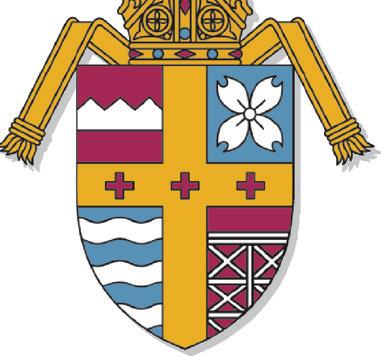

Each part of the video is immediately followed by a brief questionnaire to further develop understanding.
Education is a key
element of the Safe Environment Program

All clergy, employees, contracted school personnel, volunteers, members of groups and organizations over the age of 18 who work, volunteer, or participate in any capacity are required to complete the diocesan Safe Environment training and a criminal-background check before they can begin employment, volunteer, or participate with ministries, groups, and organizations affiliated with the Diocese of Knoxville.
In addition, the mandatory renewal training must be completed every five years and a new background check submitted before the five-year expiration of prior training.
The Diocese of Knoxville Safe Environment compliance training and renewal training is a condition of employment and for volunteer ministry in the Diocese of Knoxville.
The CMG Connect
platform contains all three elements of the Diocese of Knoxville’s Safe Environment Program: n Annual review of the Diocese of Knoxville’s Policy and Procedures Relating to Sexual Misconduct; n CMG Connect Safe Haven training program to be completed every five years; n Criminal background check to be completed every five years.
In compliance with the Diocese of Knoxville’s Safe Environment Program, all affiliates require that volunteers and employees complete the requirements prior to working and/or volunteering in a parish, school, The Paraclete, or through Catholic Charities and/or St. Mary’s Legacy Clinic
Go to https:// dioknox.org/safeenvironment on the Diocese of Knoxville website for more information ■
“We pray that educators may be credible witnesses, teaching fraternity rather than competition, and helping the youngest and most vulnerable above all.”
Pope Francis
“Dear God, we pray that our hearts be open to accepting the forgiveness and salvation offered to us through your son, Jesus. During this new year, we pray to be more like the Magi, and to recognize, understand, and trust in your precious gift to us. Amen.”© 2022 Handmaids of the Precious Blood The Handmaids of the Precious Blood in 2022 celebrated their Diamond Jubilee: 75 years since their founding in 1947; 75 years of prayer and sacrifice for priests. Did you know you can receive weekly cartoons and short reflections and news from the Handmaids of the Precious Blood? Visit their website, nunsforpriests.org, and sign up for the FIAT newsletter.
He dwells among us by Bishop Richard F. Stika

‘In the joy of your house’
— Matthew 2:23
A dwelling in Nazareth. Christmas, like Easter, is so special, so full of wonder and grace, that the Church celebrates it as an Octave—as a Sunday of eight days. And within this holy Octave of Christmas, we celebrate the feast of the Holy Family of Jesus, Mary, and Joseph It reminds us, as expressed in the Collect prayer at the beginning of this Mass, to ask God for the gift of living “in the joy of your house”—as a little house of Nazareth. And when we let our heart become such for Jesus, Mary, and Joseph, our ordinary life and acts become truly extraordinary in meaning, divine purpose, and joy.
Discounting the ordinary. Very little is revealed in the Gospels about the so-called “hidden life” of Jesus in Nazareth. So seemingly unremarkable were Jesus' days and years among the people of Nazareth before He began His public ministry, that when He returned to preach the Gospel to them, the townspeople rejected Him because there had been nothing extraordinary about His life growing up among them. They could not fathom how the kingdom of God could manifest itself in the ordinariness of this “Nazorean” of seemingly lowly origins, much less in each of their own lives (Luke 2:51; cf. Matthew 13:54-58).

But that is how God works with us—in the ordinariness of our life. So, to allow our heart to become a “little house of Nazareth” is to allow God to transform the ordinary into the extraordinary, investing it with the divine.
Extraordinary in the ordinary. These hidden years of Jesus with Mary and St. Joseph were not empty, meaningless days, as if they were some sort of long, but necessary, interlude between His birth and His public ministry, passion, and cross. Christ wanted to repair, requite, and reorder for every aspect of our fallen lives. As expressed in the Catechism of the Catholic Church, “The hidden life at Nazareth allows everyone to enter into fellowship with Jesus by the most ordinary events of daily life” (n. 533)
Though we may feel almost invisible in the


sight of others, and the ordinariness of our dayto-day life may seem meaningless, the little house of Nazareth teaches us otherwise. It invites each of us to become like a little child so that God can form His kingdom in us and reign in all the ordinariness of our life (cf. Matthew 18:3).
Hidden in the ordinary. What was the Holy Family’s life like in Nazareth? Though those many years are referred to as “hidden,” I like to think that the Holy Family’s life was merely hidden within the “ordinariness” of their lives.
Certainly, there were the general day-to-day routines we all have: the morning routine of awakening, dressing, praying, preparing meals, shopping for food and necessities, daily work, cleaning, laundering, resting, sleeping, as well as the sufferings, trials, and difficulties none of us are immune from.
But there was also a special love of silence that we must also seek to preserve within our heart and lives if the mystery of grace—God’s life in us—is to grow and invest and enliven the ordinary with the divine. Ask St. Joseph for this most necessary gift of silence and a listening heart.
God’s holy land. Jesus tells us that “The kingdom of God is within you” (Luke 17:21). Though more popularly translated as “among you,” the more accurate translation is “within you,” many scholars tell us. And this is important, for each of us is God’s “holy land,” and He wants to make our heart a most intimate garden of communion with Him. Let it be a garden home of the Holy Family!
Holy Communion. Consider how we pray the Lord’s Prayer after the consecration of the Eucharist during Mass, with its greatest petition to the heavenly Father, “Thy kingdom come,” and how immediately prior to Holy Communion we pray, “Lord, I am not worthy that you should enter under my roof, but only say the word and my soul shall be healed.”
We are about to welcome Christ and the reign of His kingdom into our heart. And what bet-
ter way to welcome Him than to ask Mary, our Mother (cf. John 19:27), and St. Joseph, our spiritual father, to assist us at this moment of communion that our heart’s dwelling should truly be a house of Nazareth. Consider how the mystical words of the Song of Songs speak to this most beautiful moment of our communion:
“When I found Him whom my soul loves, I held Him, and would not let Him go until I had brought Him into my mother’s house, and into the chamber of her that conceived me” (3:4).
Welcoming a new religious order. This is why I am particularly excited to have officially decreed and welcomed to our diocese the Benedictines of Divine Will as a public association of the faithful on Dec. 12, 2022, the feast of Our Lady of Guadalupe. For not only are they establishing St. Benedict’s monastic life of prayer and work among us, with their great love of eucharistic adoration, and devotions to the Sacred Heart of Jesus and Immaculate Heart of Mary, and to the chaste heart of glorious St. Joseph, but their greatest desire is for us to become little houses of Nazareth, where the kingdom of the Divine Will can live and reign in us as it is in heaven.
And this is what the Church has been praying for in the Lord’s Prayer, which is why they also have a strong devotion to the life and writings of Servant of God Luisa Piccarreta (1865-1947), whose cause for beatification was opened in 1994.
Come, Lord Jesus! For 4,000 years, the Israelites prayed for the coming of the Messiah. And when He dwelt among us, He taught us the Lord’s Prayer (Matthew 6:9-13), and for 2,000 years the Church has been praying, “Thy kingdom come, Thy Will be done, on earth as it is in heaven.” But in the two millennium that have passed, can we really say that His Will is done on earth as in heaven? But if Jesus taught us to pray for it—if He placed this prayer at the center of the Church’s heart as its greatest petition—then we know it will be fulfilled. And the Benedictines of Divine Will have something beautiful to share with us about this.
So, may your heart be a little home of Nazareth where the Church’s prayer echoes continuously, “Come Lord Jesus!” Come kingdom of the Divine Will! ■
Bishop Stika’s schedule of Masses and public events
These are some of Bishop Stika’s upcoming public appointments: n Monday, Jan. 2-Friday, Jan. 6: SEEK23 Conference for young adults in St. Louis n Sunday, Jan. 8, 9 a.m.: Mass at St. Joseph Church in Norris n Friday, Jan. 13, 8 a.m.: Mass and visit to St. Mary School in Oak Ridge n Wednesday, Jan. 18, 8 a.m.: Mass and visit to St. Joseph School in Knoxville n Saturday, Jan. 28, 10:30 a.m.: Mass for Consecrated Life at St. Thomas the Apostle Church in Lenoir City n Sunday, Jan. 29, 9:30 a.m.: Confirmation Mass at Church of the Good Shepherd in Newport n Tuesday, Jan. 31: Visit to St. Jude School in Chattanooga n Wednesday, Feb. 1, 8:15 a.m.: Mass and visit to Our Lady of Perpetual Help School in Chattanooga n Friday, Feb. 3, 9:30 a.m.: Mass and visit to St. Dominic School in Kingsport

“He went and dwelt in a town called Nazareth.”Follow Bishop Richard Stika on Facebook for news and events from the diocese.
God's kingdom on earth as it is in heaven begins in little house of Nazareth and in our hearts
‘A calling from the Lord’ Deacon John and Theresa Krepps share their adoption testimony
By Gabrielle NolanTheresa Krepps tells her children that even though they did not grow in her belly, they grew in her heart.
Mrs. Krepps and her husband of 39 years, Deacon John Krepps, are the parents of five adopted children, who range in age from 12 to 33 years old. The multiracial family is a mix of Caucasian, African American, and Korean.


The Krepps, who moved to Tennessee in 2017, attend St. Thomas the Apostle Parish in Lenoir City, where Deacon Krepps serves.
Starting a family
Deacon Krepps met his wife when he was a senior in college coming home for Christmas break.
“It was actually God-ordained,” he said, noting that he jokingly asked his father to fix him up on a date.

“Interestingly enough, my dad and Theresa’s mother grew up next door to each other, lived next to each other their entire lives,” Deacon Krepps said. “My grandmother actually converted her grandmother, brought her back to the Catholic Church. So, the families were very close. We actually played together when we were younger… but we never really knew each other growing up, never interacted.”
After what Deacon Krepps describes as a whirlwind romance, they were married six months later, following his college graduation.
“We knew we had very similar family values,” Deacon Krepps said. “Our families were so close.”
“We both wanted a nice-sized family,” Mrs. Krepps said.
However, her doctor made the observation that she may not be able to have children.
“We have five babies that are in heaven that we miscarried with, never went to full-term with,” Mrs. Krepps shared.
The reality of being unable to have biological children led the Krepps on a different path: foster care and adoption.
‘They’re our children’
“We still wanted to have children, so we looked at doing foster care because there’s a lot of kids out there that need good foster parents that can spend time with them and help them and get them back on track,” Mrs. Krepps explained.
Over the years while fostering, the Krepps were able to assist the lives of approximately 80 children.

“We were also foster parents to children that were up for adoption, and I just thought that would be the sweetest thing to be able to do, that I was able to hand somebody their child that they were adopting,” Mrs. Krepps said. “At the same time, we still desired our own. So, we ended up letting everybody under the sun know that we would like to adopt.”
Their first adoption, daughter Megan, happened in April 1989.
“We were blessed by a foster child who we really didn’t know, but she knew of us because we would do the Christmas Santa and Mrs. Claus at Christmas time and things like that,” Deacon Krepps explained. “She had heard through the grapevine that we were wanting to adopt a child, and she was pregnant. So, she went to her foster mother and asked if we could possibly be considered to adopt. We went through a private adoption through the attorney, and then God just opened a door after that.”
At the time, some family and friends were skeptical that the Krepps were open to multiracial adoptions.
“I think people were maybe wellmeaning in saying that you know what kind of issues you’re going to have to deal with and so on and so forth, and they’ll never really feel like they’re part of your family,” Deacon Krepps said. “And I would
say, for a period of time, I was even starting to question that in my own mind, is this what God wants us to do?”
“After we made the decision with the first child, knowing that she would be biracial because we were notified before she was born, we said yes. I think from that point on, I didn’t worry about that anymore, and when she came into our house and just beginning to raise her, it’s like that thought didn’t even cross my mind,” Deacon Krepps explained.
The door opened again a few years later with the second adoption, welcoming son Joshua into the family in October 1992.
Now that the couple was blessed with two children, they decided there were many other families out there wanting to adopt and so they would take a step back.
But in December 1995, as they were celebrating the feast of Our Lady of Guadalupe, Theresa opened up to her husband again about adopting.
“I looked at John and I said, now I know we made this agreement, but for the past couple months I really feel that God is still telling us we need to be open,” she remarked.
“So, we prayed, and I prayed specifically that a child that was in danger would literally just be dropped on the steps. On Dec. 26 we got a phone call.”
“It happened to be a nurse friend that we knew, and they needed to know right away,” Mrs. Krepps said. “Turns out the birth mother told no one about her being pregnant. … On the 25th, Christmas Day, the water broke of the birth mother, she didn’t tell anyone. She was 17 years old, and it wasn’t until the next day still nothing had happened, that she finally told her parents.”
“We felt that this was truly of God because it was a miracle he even survived. … Today he’s 6-foot1 and very healthy, and he’s doing very well,” she said of son Jordan, the third adoption.
Deacon Krepps noted that after the first two adoptions, he felt God laid on his heart to make room for another daughter. When they received the call from the hospital about the third adoption, Deacon Krepps was expecting a baby girl.

“I thought for sure, well this is the girl that the Lord had planned for us. And when we got the call on Dec. 28, and I asked if it was a boy or a girl, they said it was a boy. And I was like, oh, Lord, what are you doing to me?” he said.
The fourth adoption was, indeed, a baby girl.
“My first cousin had become pregnant, and her mother, my aunt nobody was in the position where they could raise a child,” Deacon Krepps explained. “My aunt was grief-stricken that she may not be able to see her granddaughter grow up, and she was afraid to ask us, thinking we had already raised a family. … My mom got talking to my aunt, and they said, [we] would be open to it, and so the rest is history so to speak.”
Their daughter, Emily, joined the family in January 2000.
For the fifth and final adoption,
the Krepps adopted their grandson, Jaiden, in September 2016.
“Our oldest son had some issues and the biological mother, as well, such that they were not in a position where they could raise their child,” Deacon Krepps explained.

All in the family
Below: From left to right are Jordan (27), Emily (22), Nick (son-in-law), Jaiden (12), Megan (33), and Joshua (30).
“We ended up adopting our grandson, as well, so we’re raising him now.”
“I consider them as my sons and my daughters, and I don’t feel any differently than if they would
‘Our love for the Blessed Mother’
By Gabrielle NolanHail, Mary, full of grace, the Lord is with thee.
These prayerful words are recited during the rosary at every Legion of Mary meeting, to which members unite under the banner of the Blessed Mother.
The Legion is having a resurgence within the Diocese of Knoxville, with praesidia active at six parishes. Two of those praesidia were started this fall.

Centered on prayer and spiritual works, the Legion is a “lay apostolic association of Catholics who, with the sanction of the Church and under the powerful leadership of Mary Immaculate, Mediatrix of All Graces, serve the Church and their neighbors on a voluntary basis in about 170 countries,” according to its website.

Jean Trudel is a parishioner at St. Jude Church in Chattanooga and currently serves as president of the curia, the governing body for the Legion of Mary within the Diocese of Knoxville.
“If [the praesidium] is in the individual parish, it’s like a family extending the hands and the feet of the priest, of the pastor,” she said. “He helps you and gives direction in what would be most helpful to him in reaching out to the parishioners and to the Catholic community he serves.”
Ms. Trudel noted the Legion covers three categories of works: n Conversion works, such as evangelizing non-Catholics and distributing Catholic literature; n Conservation works, such as teaching catechism or parish religious education classes; n Consolation works, such as visiting nursing homes, comforting the sick or bereaved, and reciting rosaries at funerals.
Elissa Edwards, a parishioner at Holy Ghost in Knoxville, is president of her parish’s praesidium.
“We’ll visit the sick and the homebound and pray with them. We assist with the homeless outreach, so we give out Miraculous Medals and prayer cards, and we’ll pray with them,” she said. “We visit nursing homes; we’ll do prison ministry where you go and visit those who are incarcerated. So, everything that we do is surrounded by prayer, but they’re all active works.”
John Hitt, also a parishioner at Holy Ghost, often teams with Ms. Edwards in Legion of Mary outreach.
“My favorite spiritual works include providing clothing and food and prayer for our underserved community,” Mr. Hitt said. “I also feel inspired when doing public rosaries.”
Father John O’Neill, a former priest of the Diocese of Knoxville who served as the associate pastor at St. Jude Parish from 1999-2002, noted that “the two first principles are a journey to holiness and a journey to apostleship.”
“The four rules are confidentiality about whomever you meet, reciting the Magnificat every night, coming to the meeting as a first priority, and doing substantial apostolic work, the spiritual works of mercy, every week,” he explained.
An international organization

Servant of God Frank Duff, founder of the Legion of Mary, was influenced by St. Louis de Montfort and his book, True Devotion to Mary. The first Legion of Mary meeting took place in Dublin, Ireland, in September 1921. The organization marked its 100th anniversary in 2021.
Mr. Duff, who died at the age of 91 in 1980, was a lay observer at the Second Vatican Council.
“He was introduced to the council Fathers by the archbishop of Dublin, and the council Fathers gave Frank Duff, the founder of Legion of Mary, a standing ovation. … There were about 3,000
bishops there… so that’s a big deal,” said Father John Orr, pastor of St. Mary Parish in Athens.
“So, why is it a big deal?” he continued. “Because of the 16 documents of the Vatican Council, one is on the apostolate of the laity. So, the word apostle means one who is sent, and the apostolate of the laity is that the laity are sent, like at the end of every Mass, go in peace to spread the peace we received from Christ, the Prince of Peace.”
Father O’Neill, a native of Ireland, had the privilege of meeting Mr. Duff several times.
“He was a terribly interesting man,” Father O’Neill said. “He was a very holy man, but very understated, very quiet. … The whole city really admired him, admired his work.”
The organization still stems from the headquarters in Dublin to numerous praesidia around the world.
“In the Legion of Mary there are different groupings of the legionaries, and so the highest grouping is the Concilium Legionis, so that’s in Dublin… that oversees the whole Legion of Mary,” Father Orr explained. “Then, in our case, we’re going to be under the regia of the Virginia regia.”
Under the regia comes the curia, of which Father Orr is currently the chaplain.
“The curia oversees, like in our case, the whole Diocese of Knoxville,” he said. “Then under the curia are various praesidia, and so a praesidia is normally like a parish-based grouping of the Legion. That’s really where the rubber hits the road.”
Each praesidia, of which membership is free, holds a mandatory weekly meeting for members and includes a president, vice president, secretary, and treasurer.
There are currently six praesidia within the Diocese of Knoxville:
n Our Loving Mother at Holy Family, Seymour;
n Our Lady Spouse of the Holy Ghost at Holy Ghost, Knoxville;

n Our Lady of Good Counsel at St. Henry, Rogersville;
n Our Lady Mother of the Church at St. Jude, Chattanooga;
n Our Lady of Victory at St. Mary, Johnson City;
n Our Lady Mother of the Rosary at St. Mary, Oak Ridge.
There are 46 active members across the praesidia, and 109 auxiliary members support them in prayer.

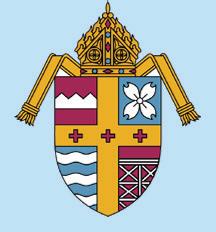
Auxiliary members are “people
who at one point were active and then for whatever reason they chose to step back, and they pray for us every day,” Ms. Edwards said.
The Legion’s spirituality Father Orr described the work of the Legion as “the work of the Church, which is the spread of the Gospel and the praise of God.”
He noted that “you can’t talk about the spirituality of the Legion without either the tessera or the handbook.”
Part of every praesidium’s meeting includes a reading from the
handbook, which Mr. Duff largely wrote. Over a period of time the entire handbook is read, and then the group starts again from the beginning.
The Legion’s handbook contains several categories, such as the Legionary and the Mystical Body of Christ; The Patrons of the Legion; Suggestions as to Works; Duties of Officers of Praesidia; Membership; and much more.
Father O’Neill explained that the word praesidium comes from the Latin word for the Roman army, meaning platoon or military unit.
The tessera, which was a Roman version of a dog tag, identified someone in the Roman Legion.
The Legion of Mary’s tessera is a prayer card that the members recite at every Legion meeting: opening prayers, the holy rosary, the Magnificat, and the Legion prayer.
The Legion of Mary’s tessera image replaces the Roman eagle with the dove, and instead of the emperor’s medal, the Miraculous Medal is in the center, with Our Lady crushing the head of the serpent. The Legion’s name is to the left and a staff to the right.
Shaping the faith of children
Parish praesidia may also have a junior praesidium, where senior legionaries work with children to actively live out the spiritual works of mercy.
When Father O’Neill was at St. Jude Parish in the early 2000s, he was the spiritual director for the parish praesidium.
He commented that the legionaries’ spiritual works primarily revolved around gathering “the children to visit the people in nursing homes,” and that it was a “huge success.”
“It was very exciting because it was a gaggle of young people coming into the nursing homes every week, and that was a huge burst of energy for them,” he shared. “It was always a rule to shake their
As Dallas charter turns 20, abuse is an issue for much of society
By Mark Pattison Catholic News ServiceTwenty years ago, in 2002, the revelations of clergy sexual abuse and its coverup in the Archdiocese of Boston were the metaphorical bombshell that fell on the Catholic Church in the United States.
The U.S. bishops, when they met that June in Dallas, approved the "Charter for the Protection of Children and Young People," a comprehensive set of procedures for addressing allegations of sexual abuse of minors by Catholic clergy.
Its one-strike-and-you're-out policy did just that permanently removing from public ministry those priests against whom abuse allegations were substantiated.
Twenty years later, at their assembly in Baltimore Nov. 14-17, the bishops acknowledged the charter's anniversary and said they have made steps in addressing clergy sexual abuse and would continue to listen, care for, and walk with survivors.
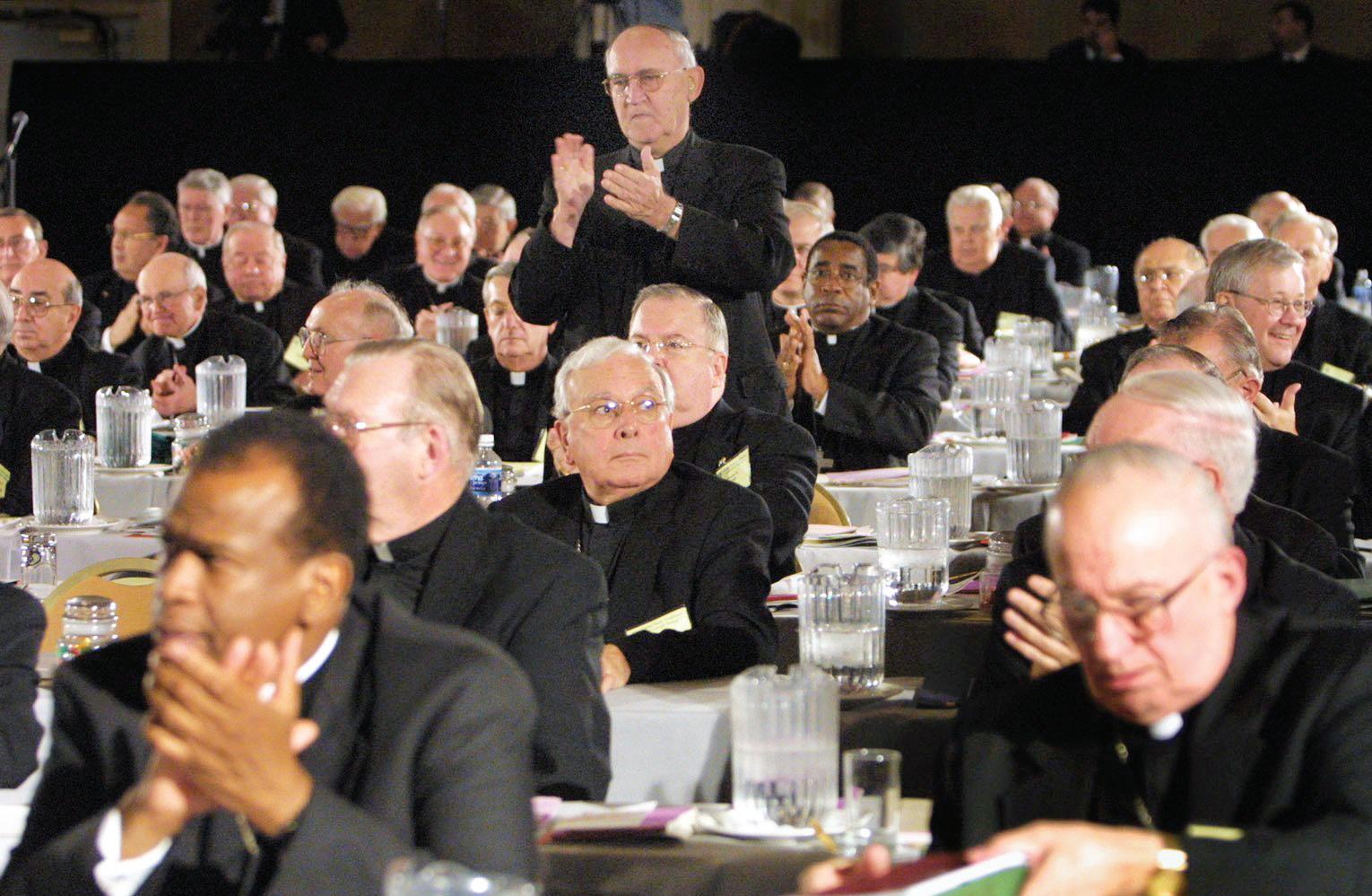
Over the past 20 years, the fallout from the Boston revelations has touched nearly every diocese. Dozens of dioceses have filed for bankruptcy protection to reach a group settlement on claims filed by abuse survivors. Many of those dioceses, though, have now emerged from bankruptcy.
The most recent diocese to announce it would file for bankruptcy protection was the Diocese of Santa Rosa, Calif., which said Dec. 5 it would file for Chapter 11 protection between Dec. 31 and March 1.
High-profile clergy also have been accused of abuse. The latest was Father Michael Pfleger, a firebrand priest who is outspoken about gun violence, gangs, poverty, and racism. He serves the faith community of St. Sabina in
we believe it’s the right thing to do. The McNabb Center shares our desire to offer dignity and a voice to those who have been victimized,” Bishop Stika added.
The new phone line to the McNabb Center’s victim’s assistance coordinator is 865-321-9080 and was activated on Dec. 27. The coordinator will respond to all reports within one business day.
The Diocese of Knoxville, established by Pope John Paul II in 1988, includes more than 70,000 registered Catholics worshiping in 51 parishes in 36 counties in East Tennessee.
The McNabb Center, previously known as the Helen Ross McNabb Center, has been the region’s leading nonprofit provider of mental health, substance use, social and victim services for decades.
Since 1948, the McNabb Center has served individuals with the most needs and fewest resources.
The McNabb Center delivers support to more than 36,750 people throughout East Tennessee each year.
The Diocese of Knoxville's program for sexual assault victim’s reporting was initiated by the U.S. Conference of Catholic Bishops in 2002 when the bishops met in Dallas and approved the Charter for the Protection of Children and Young People, a comprehensive set of procedures for addressing allegations of sexual abuse of minors and vulnerable people by Catholic clergy.
After the USCCB formalized national guidelines for dioceses to meet the Dallas Charter requirements, the diocese intiated the VIRTUS program for training all diocesan employees and volunteers who came in regular contact with children and vulnerable adults.
Under VIRTUS, employees and volunteers were required to attend training sessions that taught awareness and prevention of abusive and inappropriate behavior
Chicago, a historically African American parish.
But the 73-year-old priest in an Oct. 15 letter to parishioners said: "Let me be clear I am completely innocent of this accusation."
It is the second time the Chicago Archdiocese has asked him to step aside from ministry over an abuse claim. In January 2021, he was accused of abuse that allegedly
occurred 40 years ago. He was restored to ministry after the accusation was determined to be not credible.
In November, retired Bishop Howard J. Hubbard of Albany, N.Y., announced he has asked the Vatican that he be "returned to the lay state." He has long been criticized for his handling of abuse cases in the diocese. And because
he himself has been accused of abuse, he said, he is forbidden to function as a priest a policy he noted he backs.
The 84-year-old bishop stated Nov. 18 that he had made the request because of his age and the fact he is retired from active ministry. He also repeated his denial that he abused anyone.
The problem of sexual abuse of children, young people, and vulnerable adults is not of course just the sole province of the Catholic Church.
The Boy Scouts of America had to declare bankruptcy in 2020 after accusations of abuse roiled the organization.
Abuse has seeped into sports, in particular gymnastics. Former physician Larry Nassar is expected to spend the rest of his life in prison following his conviction five years ago on multiple charges of abuse of young gymnasts. Last year, youth hockey was in the headlines about abuse cases.
On Nov. 11, a doctor who spent two decades providing medical care to youth hockey teams in Michigan and Minnesota was charged in multiple sex assault cases.
High-ranking churchmen in other parts of the world have either had to face accusations of abuse or have admitted to abusive acts. In August, the Southern Baptist Convention acknowledged a federal investigation had begun into how it treated abuse accusations. And this just scratches the surface.
In an interview earlier this year with Catholic News Service, Cardinal Wilton D. Gregory of Washington, D.C., recalled when he was president of the U.S. bishops' conference in 2002, when the Boston scandal broke, and his first of 13 visits to the Vatican regarding the charter.
"I was told that this was an Charter continued on page A24
Diocese of Knoxville in compliance with child protection requirements
The Diocese of Knoxville is in compliance with data collection requirements for the audit period of July 1, 2019-June 30, 2022, set forth by the U.S. Conference of Catholic Bishops’ Charter for the Protection of Children and Young People.

According to a Sept. 9 letter to Bishop Richard F. Stika from the USCCB child protection auditors, StoneBridge Business Partners of Rochester, N.Y., the audit has been completed, and a compliance report has been reviewed by StoneBridge and forwarded to the Secretariat of Youth and Child Protection for use in the 2022 Audit Report ■
toward children and vulnerable adults. The training sessions were held in parishes and schools throughout the diocese.
Employees and volunteers also had to submit to a background check and complete documentation attesting that they were VIRTUS certified.
Also as part of the Church's Charter for the Protection of Children and Young People, the diocese is subject to an on-site audit each year by the independent agency StoneBridge Business Partners for compliance with all audited articles within the Charter for the Protection of Children and Young People.
The conclusions reached as to the diocese's compliance are based on inquiry, observation, and the review of specifically requested documentation.
StoneBridge has found the diocese to be in compliance in all annual audits.
In addition to the McNabb Center, the Diocese of Knoxville now works with the CMG Connect platform to administer the Safe Environment Program, which replaces the former Safe Environment Program (VIRTUS “Protecting God’s Children”).
The diocese introduced CMG Connect on July 1, 2020.
All diocesan employees are required to complete registration in the CMG Connect program.
And all volunteers are required to submit their registration, perform the training exercises, submit to a background check, and receive certification before their volunteer assignments can begin.
In addition to protecting children and vulnerable adults, the training videos include workplace and school safety.
“Since 2002, the U.S. Conference of Catholic Bishops has required safe-environment training and background checks among those entrusted with children and vulnerable adults in the name of the Church. Our diocese has maintained its own database for safe-environment records,” Deacon Sean Smith, chancellor of the Diocese of Knoxville, has said.
“Our system is designed to centralize that effort and make it easier for parishes and organizations to check whether volunteers are certified in safe-environment training or need recertification and updated background checks. The premise of our program is to streamline the safe-environment process and eliminate a lot of paperwork and make everything easier for everyone who must participate. I am quite pleased with the program,” Deacon Smith added.
CMG Connect is a service of Catholic Mutual Group, the leading provider of insurance to the Catholic Church in North Ameri -
ca. Catholic Mutual Group serves more than 125 dioceses and archdioceses, including the Diocese of Knoxville, and 200 Catholic religious orders in the United States and Canada.
CMG Connect is providing the safe-environment certification program as part of U.S. dioceses’ and archdioceses’ compliance with the USCCB’s Charter for the Protection of Children and Young People and Essential Norms for Diocesan/Eparchial Policies Dealing with Allegations of Sexual Abuse of Minors by Priests or Deacons.
According to Jennifer Mills, director of human resources for the Diocese of Knoxville, there are three elements to the safe environment program that every U.S. diocese adheres to as required by the USCCB: an educational piece, a background piece, and a policy piece.
The CMG Connect program combines all three pieces in a user-friendly, web-based program that removes the logistical complexities experienced with the VIRTUS program.
According to Mrs. Mills, the process for completing the CMG Connect certification is:
n Go to www.dioknox.org and click on the Safe Environment tab near the top of the website home page;
n Click on the CMG Connect Online Safe Environment Training tab;
n Register as a new user; once registered, users input their basic information;
n Select the job or volunteer role or roles that apply, such as priest, educator, employee, or volunteer;
n Select one of four specific employee or volunteer roles that will dictate the background check;
n Select the appropriate training exercises;
n Submit information to launch the background check;
n Then await certification by the diocese. ■
Fr. Augustine Idra marks 25th anniversary
Bishop Stika, priests, parishioners join together for Mass at St. Jude to celebrate the milestone
By Claire CollinsFather Augustine Idra, the regional superior for the Apostles of Jesus religious order and a former missionary to the Diocese of Knoxville, celebrated his 25th anniversary of ordination to the priesthood on Dec. 6 at St. Jude Church in Chattanooga.
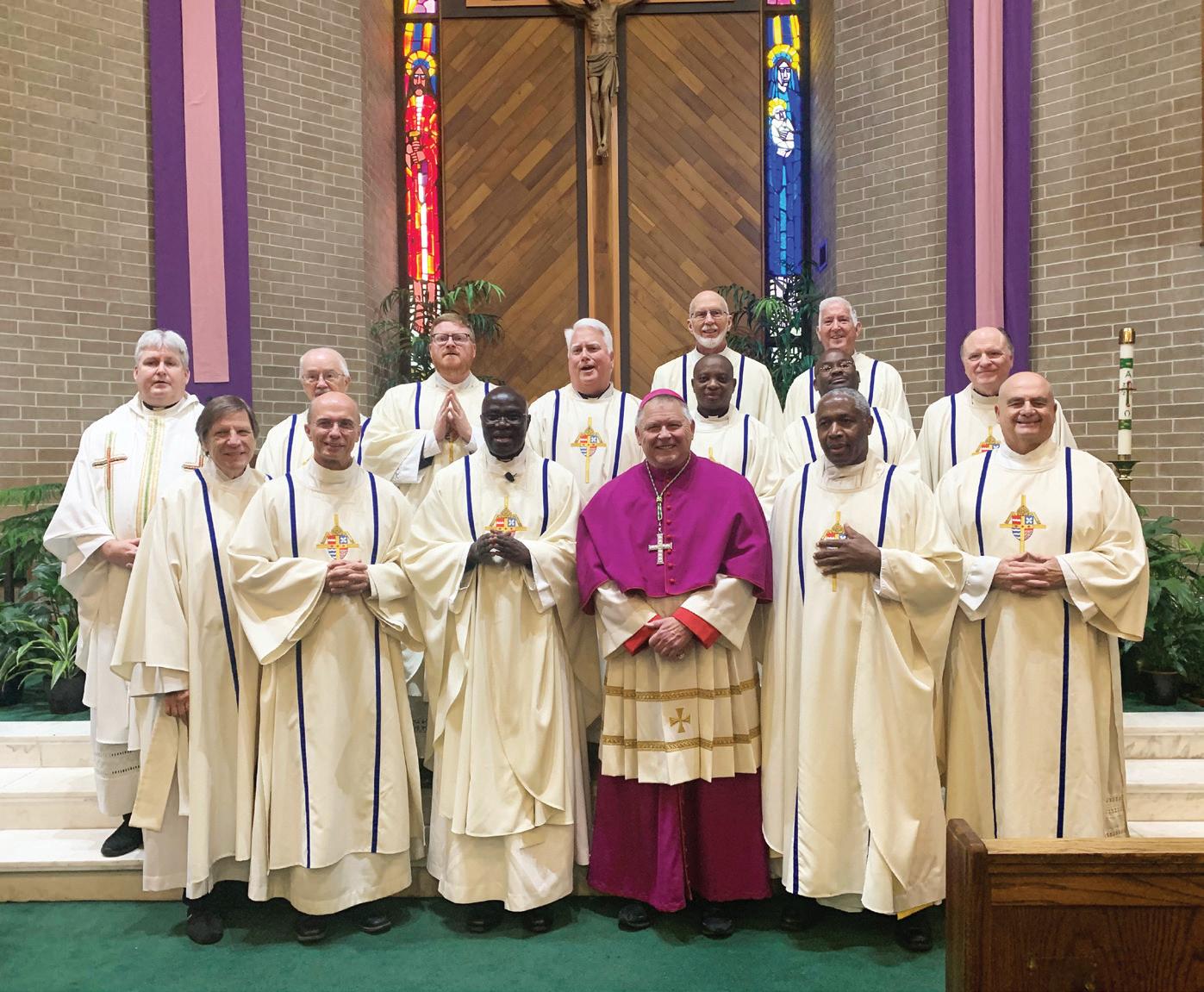
A priest known for his infectious joy, Father Idra was joined by Bishop Richard F. Stika, priests from the Diocese of Knoxville and his religious community, past students and parishioners, and many friends from throughout the country, including his former classmate, Father Barnabas Shayo, AJ, and friends from his home village in South Sudan, Africa, living in Nashville.
He was also joined in the liturgical celebration by fellow Apostles of Jesus priests Father Pontian Kiyimba, associate pastor of St. Mary Parish in Oak Ridge, and Father Emmanuel Massawe, associate pastor of St. Dominic Parish in Kingsport.
“It is fitting that we gather together this day on the feast of St. Nicholas,” Bishop Stika said. “A person who was loved for his joy and service to the community. And if you even have a glimpse of Father Augustine’s life, you know that’s what he is.”
“I am so humbled, and I have no words to express my gratitude to God for the many blessings for making me His priest 25 years ago today,” Father Idra said. “I don’t think that I do merit to this call and the priesthood that He has given me, but He chose me out of so many boys in my home village. That’s why I’m so humbled.”
Father Idra was born in Uganda to Sudanese refugees. He was given the opportunity in his youth to pursue the priesthood through the Apostles of Jesus, the first indigenous religious missionary order
Priests for Life’s Fr. Pavone responds to laicization report



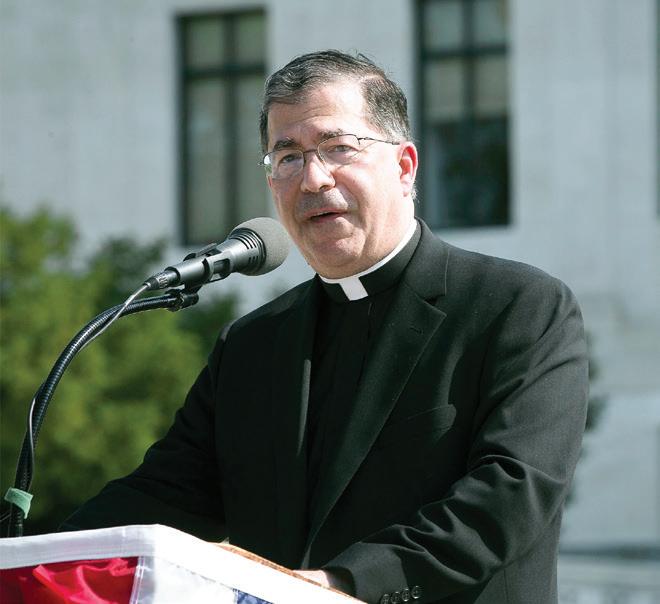 By Julie Asher Catholic News Service
By Julie Asher Catholic News Service
In a live morning broadcast on Twitter Dec. 18, Father Frank Pavone, national director of Priests for Life, said he was not told directly by the Vatican that he has been laicized.
"I haven't received any communication from the Vatican, I haven't seen anything," he said. "I'm not even being told about this myself."
Father Pavone said he learned about it from Catholic News Agency in an e-mail asking him for comment about the Vatican returning him to the lay state.
Late Dec. 17, CNA broke the story that "Father Pavone has been dismissed from the clerical state for 'blasphemous communications on social media' and 'persistent disobedience of the lawful instructions of his diocesan bishop.'"
The news outlet said it had obtained a Dec. 13 letter about the matter "confirmed by multiple sources as authentic" that Archbishop Christophe Pierre, U.N. nuncio, sent to U.S. bishops.
Shortly after the CNA story, The Associated Press, The New York Times, and several other media outlets reported the news. In an updated news story midday Dec. 18, the Associated Press published the full text of the nuncio's letter.
It said the head of Priests for Life "was dismissed from the clerical state by the Holy See" on Nov. 9. "This action was taken after Father Pavone was found guilty in canonical proceedings of blasphemous communications on social media, and of persistent disobedience of the lawful instructions of his diocesan bishop."

The letter also said the priest "was given ample opportunity

to defend himself in the canonical proceedings, and he was also given multiple opportunities to submit himself to the authority of his diocesan bishop. It was determined that Father Pavone had no reasonable justification for his actions."There is 'no possibility of appeal' for 'Mr. Pavone,'" it said.
Ahead of his Twitter broadcast, Father Pavone tweeted: "So in every profession, including the priesthood, if you defend the #unborn, you will be treated like them! The only difference is that when we are 'aborted,' we continue to speak, loud and clear."
Father Pavone and his ministry have not been without controversy over the years, and some of the biggest headlines and scrutiny his actions have drawn came in 2016 when he placed the body of an aborted fetus on an altar and broadcast it on Facebook Live on the eve of the presidential election to get people to vote for Republican Donald J. Trump.
Shortly after the broadcast, the Diocese of Amarillo, Texas, where he was incardinated as a diocesan priest in 2005, announced it was investigating the incident.

"We believe that no one who is pro-life can exploit a human body Fr. Pavone continued on page A12

“St. Jude is known as the patron of impossible cases. Father Augustine must have wondered whether the parish was the impossible case or was it him?” Father Carter asked.
“There were of course the impossible cultural norms to be learned on a steep curve. For example, homilies are to be 10 minutes long and no more! This is a hard lesson to be learned, even for me, but especially so for one used to preaching for an hour at a go. With the aid of concerned parishioners, timing devices, and a humble heart, he was able to adapt to the different expectations. He came to realize that even in 10 minutes he could convince us all that God truly does love us with an infinite love. We felt that love personally through him. ‘With God, nothing is impossible’ (Matthew 19:26),” Father Carter continued.
It didn’t take long for Father Idra’s parishioners to come to love their priest, and many were sad to see him transferred to All Saints Parish in Knoxville. Then, in 2009, he was reassigned to Chattanooga as chaplain for Notre Dame High School.


Former student Tony Tortora, who is the music and band teacher at St. Jude School, proudly attended Father Idra’s silver jubilee Mass and remembered fondly the time he had with Father Idra as his chaplain.
“I was very active in ministry singing in choir, reading when I could, and most importantly, altar serving. When we got the chance to serve with Father Augustine, we always had the best time.”
Having Father Idra was a defining part of Mr. Tortora’s high school years.
“His leadership and guidance were ever present during our high school experience. I am so grateful to have known this holy priest. He is such a kind, loving, enthu-
Catholic Charities marks anniversary of devastating fire Work continues to renovate agency's offices near downtown Knoxville
By Bill BrewerMore than a year after an arsonist broke into Catholic Charities of East Tennessee’s offi ces near downtown Knoxville and set a fi re that destroyed much of the building, the social services agency is looking forward to moving back into its facility this year.
Renovation on the one-story building is continuing as workers replace the roof structure and construct new offi ces for the Diocese of Knoxville ministry that serves more than 3,000 people annually across East Tennessee.


Lisa Healy, Catholic Charities executive director, said while authorities have been unable to identify a suspect in the Nov. 28, 2021, blaze at 119 Dameron Ave., the agency’s focus continues to be making sure all services for its clients are operating uninterrupted. The fi re occurred at the end of Thanksgiving weekend. Police discovered it when responding to an alarm at the building shortly before midnight. Firefi ghters recovered a gasoline can and a matchbook near the window the perpetrator broke to gain entry. Fire gutted much of the building’s interior, and there was extensive smoke and water damage. The interior was deemed a total loss.
CCETN was forced to relocate its administrative offi ces and several programs, including the Pregnancy Help Center, to the Regas Building on North Gay Street in downtown Knoxville immediately after the fi re.
The arson occurred at an especially challenging time for Catholic Charities, which was in the process of introducing new programs, including expansion of its pregnancy assistance work and a new partnership with Covenant Homecare for respite care for the
for any reason, especially the body of a fetus," Amarillo Bishop Patrick J. Zurek said in a statement issued after the controversial broadcast.

The use of an aborted fetus for political purposes by one of the diocese's priests violated "the dignity of human life," he added.
During President Trump's run for re-election in 2020, then-Father Pavone campaigned for him and told CNA at the time that canon law's prohibitions against political involvement by clergy did not apply to him because he was campaigning against abortion and for the pro-life cause.
He did eventually end his role as a co-chair of Trump’s 2020 pro-life coalition and as an advisory board member of Catholics for Trump, telling CNA he stepped down "at the request of 'the competent ecclesiastical authority.'"
In his live broadcast on Twitter Dec. 18, Father Pavone said he will not apologize for actively supporting President Trump, "who got us to this point where we are now." He was referring to President Trump's appointees to the U.S. Supreme Court joining in the majority vote on June 24 that overturned Roe v. Wade, the 1973 ruling that made abortion legal nationwide.
In his Twitter broadcast, Father Pavone took issue with being accused of "blasphemous communications" on social media.
He admitted getting angry with a "rabid (President Joe) Biden supporter" during a conversation the two were having on Twitter, and he tweeted the "GD" word: "You and these ... baby-killing politicians."
"I shouldn't have used that word I don't usually use that word in response to that guy," Father Pavone told his listeners. "I was very angry, so I (went) to confession" afterward.
"Father Frank is damning people
homeless at CCETN’s Samaritan Place facility.
All the programs got underway despite the logistical diffi culties.
“[The fi re] hasn’t impeded our operations. I feel like we’ve really excelled at servicing our clients. It’s really beyond business as usual because we’ve opened new business,” Mrs. Healy said.
to hell? I don't think so," he said, citing several examples of "extending the mercy of God" to those who have supported abortion.
In his pastoral work with Rachel's Vineyard, a post-abortion retreat ministry, he has extended "the mercy of God" to countless women who regret their abortions, he added. "Don't talk to me about damning people to hell."

Originally ordained for the Archdiocese of New York by Cardinal John J. O'Connor in 1988, Father Pavone took over the helm of Priests for Life a couple of years after its 1991 founding.
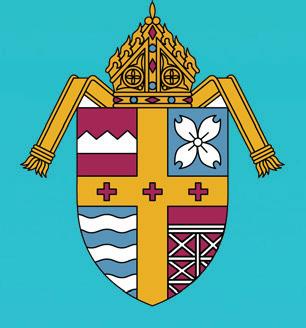
In 2005, Father Pavone told Cardinal Edward M. Egan, then New York's archbishop, that he wanted to pursue his pro-life ministry full time and had been invited to do so by Bishop John W. Yanta of Amarillo who served on the Priests for Life board of advisers. Father Pavone was incardinated into the Texas diocese that year.
In 2011, Bishop Zurek, Bishop Yanta's successor, suspended Father Pavone from active ministry outside the diocese.
The priest appealed to the Vatican, and in 2012, what's now the Dicastery for the Clergy, issued a decree allowing Father Pavone to minister outside the diocese but said he would still have to obtain specific permission to do so from Bishop Zurek.
In 2014, New York Cardinal Timothy M. Dolan cut ties with Father Pavone and his group Priests for Life, saying the priest refused to allow an audit of the group's finances. Priests for Life was based in Staten Island, N.Y.
In 2017, Priests for Life announced it had relocated its headquarters to Titusville, Fla.

In April 2020, Father Pavone told CNA he was no longer "under the authority" of the Amarillo Diocese and would not say what diocese he had moved to. ■
While Catholic Charities has been grateful to have quality offi ce space in which to relocate that is relatively near its Dameron Avenue building, it is not home.
“It’s quite a bit less space at the Regas Building. Some of our services are limited, like our inhouse pregnancy testing. We can’t do that until we’re back in our


“We expect to fi nish the renovation no later than June. ... We think it’s very important to continue using that building for client services. We’re across the street from the Knox County Health Department, and we’re on a bus line. We’ve been in that building since the 1980s, and people know where we’re located.”
building,” Mrs. Healy said.
Mrs. Healy is proud of the work her staff has done under trying circumstances, all of which is targeted to East Tennessee residents in need of social services.
The arson didn’t keep Catholic Charities from opening critical ministries in an underserved part of East Tennessee and for mothers and fathers considering adoption.
“We renovated and opened the Helenwood Pregnancy Center in Scott County to serve people who really need that assistance. It allowed us to create more active partnerships with our partners in the diocese, like the St. Mary’s Legacy Clinic,” Mrs. Healy said.
“And we opened adoption services in the diocese,” she added.


In July, Catholic Charities of East Tennessee Adoption Services offi cially launched, and the program is available to parents considering adoption to grow their families as well as expectant mothers who are considering placing a child for adoption.
It is the fi rst time in nearly 10 years that adoption services are again available by a Catholic organization in East Tennessee.
Adoption isn’t the only way Catholic Charities is assisting children.
Bishop Barron: Bible is ‘key to evangelization’ and soul of theology
By Julie Asher Catholic News ServiceBishop Robert E. Barron is convinced "the Bible is the key to evangelization."


"That's the soul of theology. It's where we started," he said, noting that the Second Vatican Council really brought "the Bible to the fore" for Catholics. "But I always felt we've not realized that Vatican II vision of revitalizing the Bible."
The Catholic Church is "not a philosophy or a kind of self-help program," Bishop Barron added. "We're based upon God's revelation to us. And that's the Bible."
Vatican II recommended that "easy access to sacred Scripture be provided to the Christian faithful" (Dei Verbum) and that a "warm and living love for Scripture" be encouraged (Sacrosanctum Concilium).
The Diocese of Knoxville social services agency opened the CoHo Safe Place for Kids as part of its Columbus Home Children’s Shelter and Assessment Center program. The Children’s Emergency Shelter and Assessment Center provided 245 bed nights to children in distress in the last year.
“We’ve addressed some of the needs for the children of Knox County with our Safe Place for Kids. This is a temporary shelter that [Department of Children Services] utilizes when they have children in custody. It houses children when they aren’t in school. It’s a full-service children’s shelter with resources for studying, tutoring, recreation, as well as food, clothing, showers, clean linens and towels, and laundry services,” Mrs. Healy explained.
“We try to be helpful in providing a safe place for children who are navigating juvenile court and DCS,” she added.
And then there are the existing CCETN programs that are continuing unabated, such as the annual holiday celebration in rural Campbell County.
“We still did Christmas for the kids at the Crazy Quilt facility in Newcomb, where we provide food and toys for over 200 families,” Mrs. Healy pointed out. “And we provided over 200 meals in Western Heights with Hope Kitchen.”
Western Heights is a lowerincome community in Knoxville’s inner city.
Another example of CCETN’s growing social services portfolio, according to Mrs. Healy, is the Columbus Home Assisting Parents (CHAP) program, which is a home-based parent education and support service that provides parenting education, crisis intervention, and case management for
A former auxiliary of Los Angeles who now heads the Diocese of Winona-Rochester, Minn., Bishop Barron spoke to Catholic News Service about the Word on Fire Catholic Ministries' Bible project, which will be a seven-volume series
when completed.

He is the founder of Word on Fire, a global apostolate that uses digital and traditional media to introduce Catholicism to the broader world.
There are 300,000 copies of the Bible project's first two volumes already in circulation. The first volume includes the four Gospels, and the second volume includes the Acts of the Apostles, the Letters of the New Testament, and the Book of Revelation.
The Word on Fire Bible "is transforming the way people read, understand, and pray with the Word of God," said a recent announcement on the launch of a donor campaign to produce the third volume.
The upcoming volume will feature the first five books of the Old Testament, commonly called the Pentateuch: Genesis, Exodus, Leviticus, Num-
Bible continued on page A16
our administrative offi ces.”
Not returning to Dameron Avenue hasn’t been a consideration, according to Catholic Charities’ executive director.
“We think it’s very important to continue using that building for client services. We’re across the street from the Knox County Health Department, and we’re on a bus line. We’ve been in that building since the 1980s, and people know where we’re located,” she noted.
And while insurance is covering most of the cost for the fire renovation, it doesn’t cover everything.
Catholic Charities is hoping to raise funds for building needs not covered by insurance, such as a perimeter fence, supplies for the Pregnancy Help Center, supplies for the new ultrasound clinic that will be in the building as part of the Pregnancy Help Center, and landscaping.


Anyone interested in making a donation to Catholic Charities of East Tennessee can go to the CCETN website, ccetn.org , or call 865-524-9896
Mrs. Healy is looking forward to the fruitful return of another Catholic Charities ministry that was halted due to the fi re.
“In May, we’ll be replanting our community garden as well,” she said.
families that experience life stressors that impact parenting abilities.
The CHAP services are provided free of charge to parents.
The Catholic Charities staff is looking forward to moving back into its Dameron Avenue building.
Nigerian faces execution for defending Christian
By Peter Pinedo Catholic News AgencyRhoda Jatau, a Christian and mother of five, has been charged with blasphemy in a Nigerian court for forwarding a video defending a lynched Christian student.
During her arraignment on Dec. 19, Ms. Jatau was officially charged with blasphemy, inciting a mob, and exciting contempt of religious creed. She is being tried in the northeast Nigerian state of Bauchi’s high court. Bauchi practices a form of Sharia law, under which blasphemy is a crime punishable by execution.
Ms. Jatau, a 45-year-old medical worker, was arrested by Nigerian authorities on May 20 and has been held without the ability to communicate and without a trial for over six months, which is against both Nigerian and international law, according to religious rights advocates.
She was arrested after forwarding a video of a Muslim denouncing the mob killing of Nigerian Christian college student Deborah Emmanuel.
The student was killed on May 12 by a lynch mob of fanatical Muslim students who accused her of blasphemy. Ms. Emmanuel was stoned and burned to death for posting to social media that Jesus had helped her do well on an exam.
Ms. Jatau forwarded the video defending Ms. Emmanuel via Whatsapp to her work colleagues at the Primary Healthcare Board of the town of Warji. Some of her co-workers reported the video, and Jatau was subsequently accused of blasphemy. ■
“We expect to fi nish the renovation no later than June,” Mrs. Healy said. “We’re creating a space that will provide client services, adoption, pregnancy help, and the offi ce of immigration. The back part of the building will be
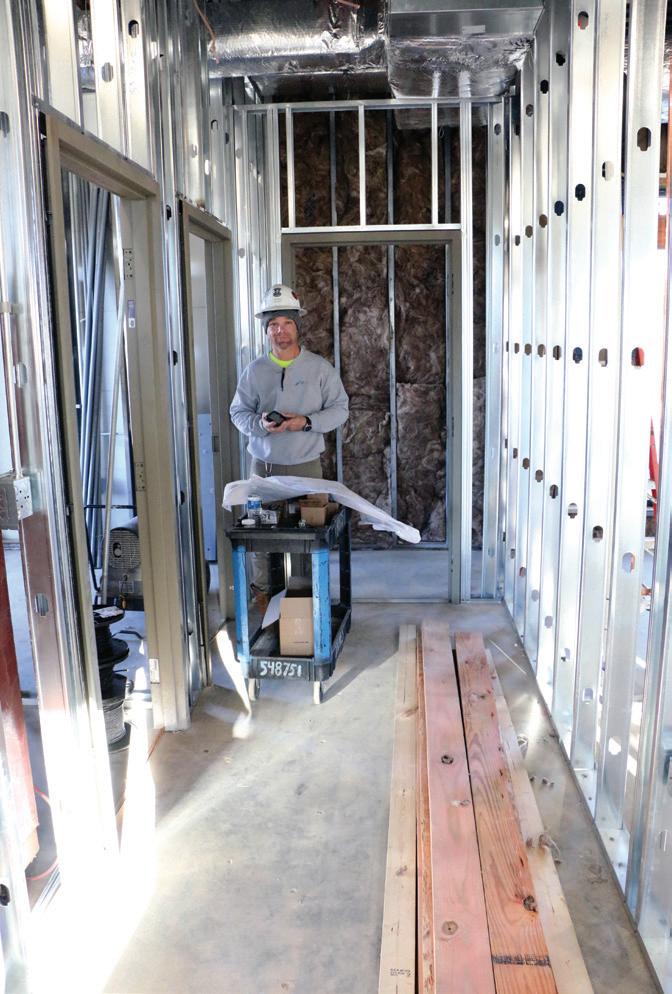

Catholic Charities employees partner with their Dameron Avenue-area neighbors in growing a vegetable garden on the CCETN property each season. The neighbors help take care of the garden and are the recipients of its free produce.
It’s yet another CCETN activity that everyone involved enjoys, takes pride in, and feels a deep sense of making a difference in people’s lives. ■
Food Shipments Funded by US Catholics Are
Bringing Relief to Families at Risk of Malnutrition
To combat hunger in developing countries, Cross Catholic Outreach has a simple but effective plan: Ship in Vitafood.

Vitafood is a fortified rice product specifically designed to fight the effects of child malnutrition, and it can be packed in large shipping containers and cost-effectively sent to Catholic schools, orphanages and other local partners serving the poorest of the poor. A single container can keep crucial feeding programs running or provide immediate relief when disasters strike.
“Credit for the success of our Vitafood outreaches should really go to the compassionate Catholics in the U.S. who help us secure and ship these self-contained meal packets to Catholic missions around the globe,” said Jim Cavnar, president of Cross Catholic Outreach, a Vatican-recognized charity serving missionaries in the developing world. “Church leaders in Haiti, Guatemala and other developing countries are eager to help the hungry poor in their communities, but they need us to supply them with resources like this food. Getting a steady supply of Vitafood is critical to their programs. In some cases, where hunger is extreme, these meals can even save lives.”
According to Cavnar, Vitafood is also an extremely flexible resource. It comes in several different varieties and can be prepared with additional spices and ingredients to suit local tastes. Vitafood provides the optimal balance of vitamins, minerals, protein, fiber, fat and carbohydrates that a child’s hungry body needs. These meals are also important to the health and physical well-being of children and adults who are healthy but at risk of becoming malnourished.
What’s more, because Vitafood meals are donated to us by
respected faith-based organizations, Cross Catholic Outreach only needs to cover the cost to ship the meals to hungry families. This means that for every dollar donated, 14 nutritious meals can be sent to a community in need.

“There are very few donations a person can make that achieve this much bang for the buck,” Cavnar pointed out. “Some of our donors are so impressed with the impact that they sponsor the shipment of an entire 40-foot container filled with food, effectively supplying the poor with tens of thousands of meals.”
Support for this outreach is
particularly important now, according to Cavnar. The COVID19 pandemic, the military conflict in Ukraine and widespread inflation have made obtaining food much harder for overseas missions.
“Our goal is to support those struggling Church leaders by bringing in the food they need. The health of poor families is at risk if we don’t,” Cavnar said. “As I see it, this is our opportunity to be a blessed instrument of mercy. It is our chance to further the work of the dedicated priests, sisters and Catholic lay missionaries who are doing everything they can to respond to this threat.”
Readers interested in supporting Cross Catholic Outreach food programs and other outreaches to the poor can contribute through the ministry brochure inserted in this issue or send tax-deductible gifts to: Cross Catholic Outreach, Dept. AC02232, PO Box 97168, Washington, DC 20090-7168. The ministry has a special need for partners willing to make gifts on a monthly basis. Use the inserted brochure to become a Mission Partner or write “Monthly Mission Partner” on mailed checks so we can contact you about setting up those arrangements.
Unique Christmas Catalog Created To Bless Donors
— and the World’s Poor
If you are like most people, your mailbox has been choked with Christmas catalogs this year. In fact, their arrival has almost become a sign of the season, like the appearance of house lights and department store decorations.
This Advent and Christmas season, Cross Catholic Outreach intends to offer a catalog too — but theirs is a very different offering with a very different purpose. It has been designed to bless both givers and receivers by using the holiday gift-giving tradition to help the world’s poorest families.
Rather than offer gizmos, gadgets, neck ties and jewelry, the Cross Catholic Outreach Christmas Catalog is giving Catholics with a concern for the poor an opportunity to share the blessings in their lives with needy families by sponsoring practical and urgently needed items like medicines, milk powder, seeds for farming, access to safe water or materials for roof repairs. Of course, it also offers blessings for children, including toys and sports equipment, so individuals can choose to sponsor both practical items suitable for families and gifts
to bring children joy.
“Like most Christmas catalogs, ours offers lots of items so donors can choose to give something very specific. That said, they can also make a general gift to address the poor’s greatest needs,” explained James Cavnar, president of Cross Catholic Outreach, the Catholic relief and development ministry offering this program.
“When donors choose to give to greatest need, they provide us and the Catholic missions we serve with the freedom to address any urgent need. The priests and
religious sisters we support really appreciate that flexibility. It’s the best way to empower their work among the poor.”
This unique Christmas catalog is easy to access. Readers will find a link for it at the ministry’s website (CrossCatholic.org) or they can reach it by directly entering the web address: CrossCatholic.org/ Christmas.
“Our hope is that everyone will be blessed by the experience,” Cavnar said. “It’s a wonderful way for us to celebrate the birth of our merciful Lord!”
Catholic Missions Use School Lunch Programs to Feed Hungry Children in Poor Communities

Extreme hunger has been on the rise in developing countries around the globe, but Catholic missions have developed an effective way to combat the problem — especially where children are at risk, They have instituted school lunch programs to ensure needy boys and girls in the poorest communities receive at least one nutritious meal.
story indicates just how critical Catholic school lunch programs are to the children in developing countries like Haiti, Guatemala and Nicaragua.”

Once you have seen the extreme poverty families face in the developing countries Cavnar listed, it is easy to understand why hunger is such a frightening prospect to the parents in those places. Life is very hard for poor families in those nations, but it is particularly challenging to those living in rural areas where whims of weather can so easily disrupt their incomes and their lives.
number of children in one place and at one time.
Sadly, for some of the participating children, that school lunch is the only food they will eat all day.
“I once met a poor father who grieved every time the weekend approached because he had no money and no food to offer his children on those days. He knew his kids would eat when they went to the Catholic school on weekdays, but when his kids were home on the weekends, they often went hungry,” shared Jim Cavnar, president of Cross Catholic Outreach, a respected relief and development ministry working in these impoverished areas. “We eventually found a way to deliver general food supplies to his community, but his
“Most rural families are subsistence farmers,” Cavnar explained. “They work very hard, but it is still a struggle for them to feed their families. When the weather doesn’t cooperate or pests destroy their crops, their children go hungry — and some even fall prey to malnutrition. That’s a very dangerous condition because it puts their sons and daughters at risk of long-term mental and physical impairments. It also weakens immune systems, which produces additional problems when an illness such as COVID-19 strikes. In fact, almost any serious illness or disease can be deadly when your immune system is compromised.”
Solving this hunger problem required Cross Catholic Outreach to find a solution that would costeffectively reach a significant
“Catholic schools were identified as the most logical place to host a feeding program, so we made it a priority to supply them with food for lunches,” Cavnar said. “We have other methods of getting food out to hungry families, but the school-based feeding programs are the most effective ways we can put healthy meals in the hands of needy boys and girls. We also supply Vitafood to those schools whenever possible because the meals are specifically formulated to be both highly nutritious and culturally appropriate to the countries we serve.” (See related story on the opposite page.)
Beyond satisfying the hunger of children, the program also has an important educational impact, according to Cavnar.
“Hungry children struggle to concentrate in school, and eventually they fall behind. When
How to Help
a family finds it hard to make ends meet and their children don’t seem to be progressing in their studies, those parents are tempted to pull their sons and daughters out of school altogether. We can’t let that happen. We need to ensure these children are able to succeed in school so they can eventually break free from the poverty that has plagued their families for generations.”
While Cavnar believes the schoolbased feeding programs currently underway are successful, he believes even more can be done if Catholics in the United States remain committed to the cause and generously support the Church’s efforts.
“Now that they understand the hardships hunger creates, I’m optimistic my Catholic brothers and sisters in the U.S. will be eager to help,” he said. “That’s because every meal we are able to ship can have a life-transforming impact on a child.”
“ ... when [they] were home on the weekends, they often went hungry.”
Jim Cavnar, Cross Catholic Outreach
Will Messi keep promise to Virgin Mary after winning World Cup? International soccer star has vowed to make pilgrimage to basilica in home country
By Catholic News AgencyAfter Argentina’s victory at the 2022 World Cup in Qatar, a promise made by soccer superstar Lionel Messi to the Virgin Mary has resurfaced. Will he fulfill it?
Mr. Messi, 35, played his fifth World Cup wearing Argentina’s jersey, and the team became world champion by beating France 4-2 on penalties on Dec. 18.
Considered one of the best players in the world, Mr. Messi has won 40 titles, 34 with Futbol Club Barcelona (FC) in Spain, two with Paris Saint Germain (PSG) in France, and four with the Argentine national team. In his career, according to his own words, “this was missing” — to be world champion as a member of his country’s team.
In 2014, the team of which he is captain reached the final in the World Cup in Brazil, where they lost to Germany. In Russia in 2018, Argentina was left out of the competition in the Round of 16.
It was precisely at that World Cup that he made a special promise to the Holy Mother.
In an interview in Moscow with the Argentine journalist Martín Arévalo, Mr. Messi was challenged by the reporter to walk “to Luján or to San Nicolás,” two of the most important shrines in Argentina, if the team won the World Cup.

Lujan, Argentina, is the site of the National Shrine of Our Lady of Lujan, the patroness of the country, which every year attracts millions of pilgrims.
In San Nicolás—a city near Rosario, Mr. Messi’s birthplace—is the Shrine of Our Lady of the Rosary of San Nicolás, which has a history of Marian apparitions that began in 1983 with messages from the Blessed Virgin to Gladys Quiroga de Motta.
The apparitions were approved by the Catholic Church on May 22, 2016, through a decree signed by the then-bishop of San Nicolás, Héctor Cardelli.
In the 2018 Moscow interview, Mr. Messi promised that he would walk from his home in the town of Arroyo Seco to the Basilica of San Nicolás, a distance of about 24 miles, and shook hands with the journalist as a sign of commitment.
During his career, Mr. Messi has shown devotion to God and to be a believer. After winning the World Cup, his statements to the press did not omit the role that he attributes to the Lord in the victory: “I knew that God was going to grant this gift to me, I had a presentiment that it was going to be this,” he told the TyC Sports television channel.
Pope Francis gave a shoutout to the 2022 FIFA World Cup in Qatar at the end of a weekly audience when the world soccer champion-
bers, and Deuteronomy.
There are "tons of study Bibles out there," which are "full of all kinds of good information," Bishop Barron acknowledged. But many have "super small print and lots of thick footnotes" and are "probably hard to read, especially for someone who is unacquainted with the Bible."
The volumes of the Word on Fire Bible use high-quality paper and aim to offer more to readers by juxtaposing scriptural text with scholarly commentary from Bishop Barron, the Fathers of the Church, saints, mystics, theologians, scholars throughout history, and contemporary Catholic figures. The books also have ample religious art.
Bishop Barron said this format draws more readers in including, he hopes, one "target audience" in particular the "nones," those who describe themselves as religiously unaffiliated.
"We tried to imagine someone who's had very little experience with the Bible" and would find it "so offputting" to open up a Bible with tiny print, footnotes, and double-column
ship began in November.
Speaking to a crowd of people from around the world on Nov. 23, the pope expressed his hope the international soccer competition would foster fraternity and peace.
“I wish to send my greetings to the players, fans, and spectators who are following, from various continents, the World Cup, which is being played in Qatar,” he said in St. Peter’s Square.
“May this important event,” he continued, “be an occasion of encounter and harmony among nations, fostering fraternity and peace among peoples.”
Pope Francis added to his appeal for peace, asking for prayers for an end to all conflicts, especially the conflict in Ukraine.
He highlighted the upcoming anniversary, Nov. 26, of Holodomor,
also known as the Terror-Famine or the Great Famine, a man-made famine that took place in Soviet Ukraine from 1932 to 1933.
Pope Francis called Holodomor a “terrible genocide” and an “extermination by starvation,” which was artificially caused by Joseph Stalin.
The 2022 FIFA World Cup was played in the state of Qatar, an emirate on the northeastern coast of the Arabian Peninsula, from Nov. 20 to Dec. 18.
The choice of Qatar as host country for the men’s soccer tournament has been criticized due to conditions in the country, including the situation of Christians.
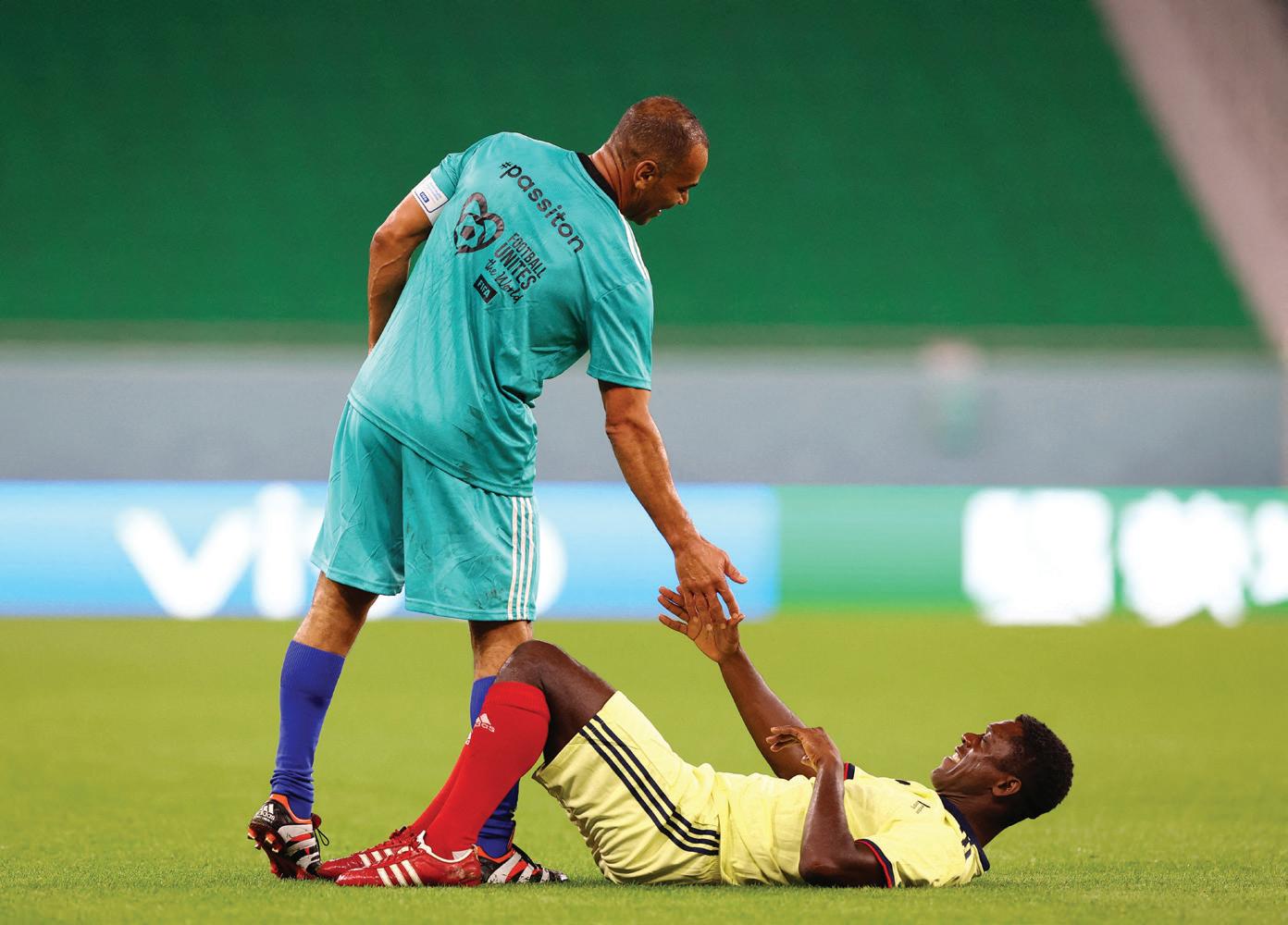
Bishop Stefan Oster of Passau, who is the current sports commissioner of the German Bishops Conference, said in a statement published Nov. 17 that he did not

want to give soccer fans “a bad conscience,” even if people were “asking how it came about that Qatar, of all places, was chosen by FIFA as the host country 12 years ago.”
“Non-Islamic religions, including Christianity, which are strongly represented among migrant workers, are granted freedom only to a limited extent,” the German prelate said.
Bishop Oster also said the role of women was “set back” and sexual minorities were prosecuted.
Bishop Oster, who is known as the “sports bishop” of the German Bishops Conference, called for a critical look at conditions in the competition’s host country, including the situation of Christians.
“Enjoyment of sports, including worldwide mega-events, has its own right, even if it may be clouded by the extreme commercialization of soccer in particular. But it is nevertheless right to take a critical look at the political and social conditions in Qatar.”
Bishop Oster noted that the emirate applied for the 2022 World Cup to underscore its international importance and reputation.
“So it is only appropriate that the spotlight of the public is directed on the country these days and that the problematic aspects are also illuminated,” he said.
Bishop Oster said the emirate had been “catapulted into a new era in recent decades by its oil and gas wealth. Today, a conservativetraditional Islamic society and an economic hypermodernity coexist. It would be unfair to ignore this special situation in the necessary criticism of questionable conditions. But it would also be inappropriate to gloss over limited human rights.”
“Experience shows that major sporting events such as world championships and Olympic games do not usually improve the social and political situation in the host countries in the long term,” he noted.
“For this very reason, it remains the task of the international community to continue to support the reform forces in the country even after the conclusion of the World Cup in Qatar and not to let up in its attention to human rights,” he continued.
The bishop said the “living and working conditions of the migrant workers who built the sports facilities and developed the country’s infrastructure in recent years deserve special attention.”
Describing conditions on construction sites as having been catastrophic, “leading to an immense number of accidents and far too many deaths, especially during the construction of the stadiums,” the bishop said problems had not been satisfactorily solved, despite improvements. ■
The third volume will showcase over 50 works of art. Its dozens of commentaries will include perspectives from Dorothy Day, co-founder of the Catholic Worker Movement; St. Ephrem the Syrian, one of the first to introduce song into the Church's public worship as a means of instruction for the faithful; St. Hildegard of Bingen, a Benedictine abbess and mystic; and St. Bernard of Clairvaux, a Benedictine abbot who also was a mystic.
The Bible project is funded by donors. For each level of giving, ranging from $50 to $5,000, the donor receives a thank-you gift or gifts, which can be an art print or an art print and a paperback, hardcover or leather-bound copy of the Bible volumes. The combination depends on the amount contributed.
type on thin paper, he explained.
"So we wanted to do something that would be very inviting, especially to someone unacquainted with the Bible," he said. "So everything we did was designed to be more attractive and to draw that person in. So, that was the inspiration behind it."

"The beautiful" is "going to lead you to the true and the good," so
"we want the book itself to be something beautiful," Bishop Barron told CNS in an interview during the U.S. bishops' fall general assembly in Baltimore.
"This book is a holistic experience that's meant to appeal to your eyes, to your imagination, to your mind. It's, I think, by its very nature meditative," he said.
Reserved copies of the third volume will be available next summer.
The leather-bound, hardcover, and paperback editions are printed in Vincenza, Italy, by Legatoria Editoriale Giovanni Olivotto.
More information about the Word on Fire Bible project is at www. wordonfire.org/bible-project
“Enjoyment of sports, including worldwide mega-events, has its own right, even if it may be clouded by the extreme commercialization of soccer in particular. But it is nevertheless right to take a critical look at the political and social conditions in Qatar ”— Bishop Stefan
OsterDiocese of Passau in Germany
hands, give them a hug or a kiss, make sure you said an Our Father, Hail Mary, and Glory Be.”
One memory in particular sticks out to Father O’Neill.
“I remember one place, it was a very quiet evening, maybe a little lonely for the people, and I told the girls, walk down the corridor and greet everybody. And it was like sunflowers for people sitting in their chairs as these young people greeted them each individually,” said Father O’Neill, who is pastor of Holy Trinity Parish in Hohenwald, Christ the Redeemer Parish in Centerville, and St. Cecilia Parish in Waynesboro, all in the Diocese of Nashville.
“It was a huge formation for the children. I think there were several vocations through it, at least in Chattanooga. The children loved the organization, they loved the meeting, they had to give their reports, say their prayers, read from the handbook,” he said.
It also was one of Father O’Neill’s goals to ensure that no person in the parish died without receiving the sacraments.
More than once, an elderly person would die soon after being visited by the Legion of Mary and the children. Some of the children caught on to this, to which Father O’Neill told them, “These people have been waiting to be loved personally by you and the other children and to receive the sacraments and see that they are loved by God, and then they can let go.”
‘An extended family’ Paul and Marieta Dunn, longtime Holy Ghost parishioners, are Legion of Mary members who regularly take the mission out into the community.


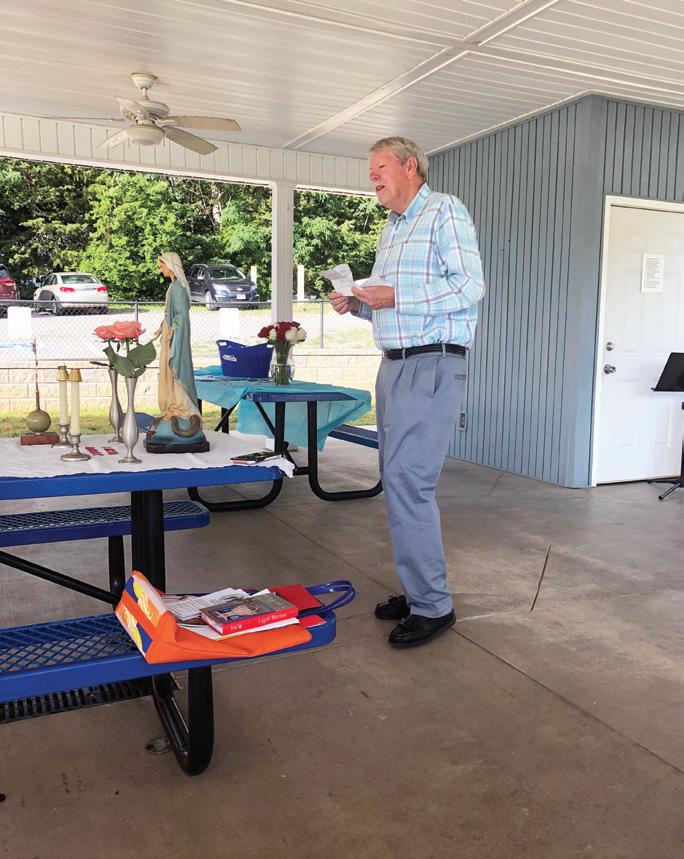


“The Legion of Mary gives us the opportunity to pray the holy rosary with other members of Holy Ghost. Of the many possible works within the Legion, Marieta and I participate in outreach by leaving literature at stores and restaurants in which we shop,” Mr. Dunn said.
“About every six weeks, a table is set up at Market Square in downtown Knoxville with an assortment of rosaries and literature about the Legion of Mary. We enjoy spending time talking to the people that stop by the table,” Mrs. Dunn added.
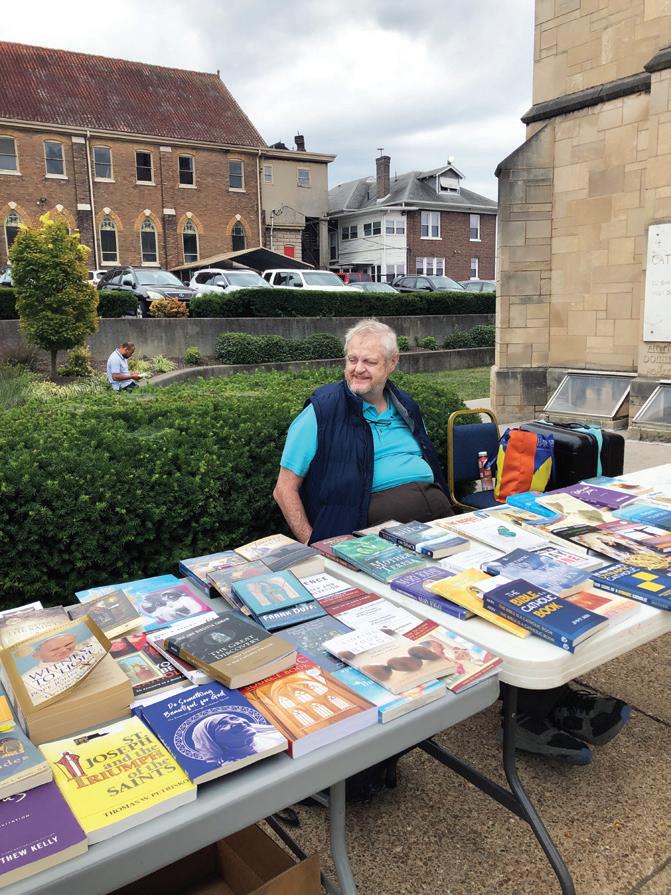

Ms. Edwards said the Legion is special because of “our love for the Blessed Mother,” while also noting that the Legion has “especially deepened” her own devotion to Mary.
“It’s allowed us the ability to make friends with people we might not normally have been introduced to. It has expanded our faith,” she said. “I know it takes me out of my comfort zone when I’m standing in the midst of a group of homeless people, and I’m talking with them and giving them Miraculous Medals and praying with them. It’s
not something that I thought that I would be doing, but I look forward to it. Sometimes I think I get greater joy.”
Mr. Hitt acknowledged that one of the reasons he converted to Catholicism was the Church’s devotion to the Blessed Mother.
“I saw the Legion as another source for me to increase my knowledge and love for Mary,” he said. “The depth and variety of the members’ love for Mary has deepened my faith.”
“If anyone is interested (in the Legion), I suggest that they come to a couple of meetings, see what we’re about, ask questions, join us at some events, and then make a decision that way,” Ms. Edwards said.
Father Orr said that if anyone is interested in starting a praesidium at their own parish, they should talk to their pastor.
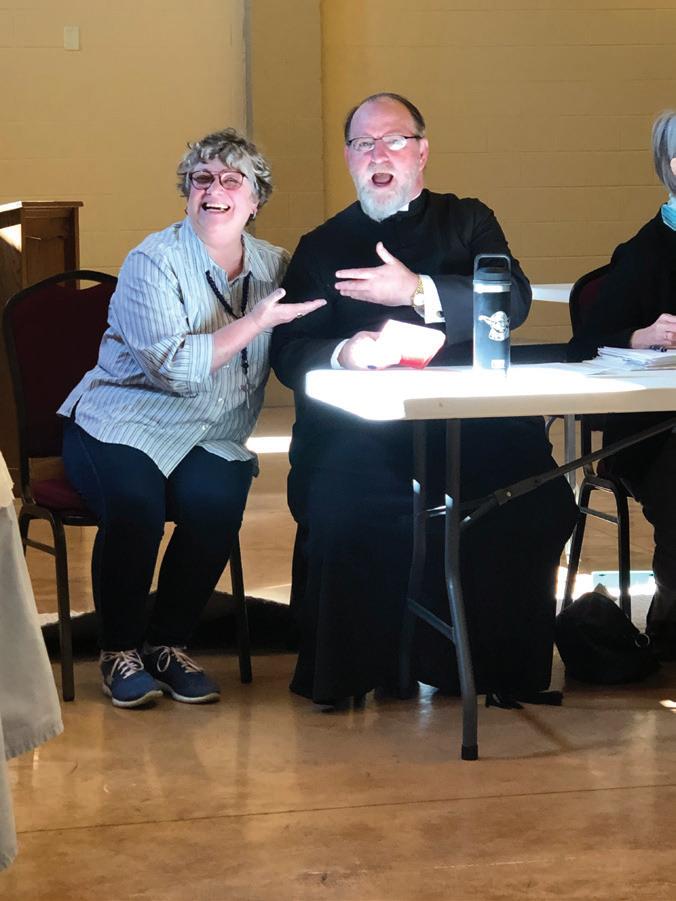
“The spiritual director for the praesidia is normally a priest and normally the pastor,” he explained.
Father Charlie Burton, who is pastor of St. Jude Parish, remarked on the importance of the Legion of Mary.
“The Legion of Mary is a vibrant and essential ministry within our parish. Their ministry of devotion to Jesus and His Blessed Mother, prayer, and spiritual care of the sick and homebound is a true blessing to our parish and myself as a pastor. They have an open willingness to serve the needs of others whenever they are called upon, as well as volunteering to search for ways in which they can serve their fellow parishioners and those in need,” he said.
However, if a parish does not currently have a praesidium, individuals could find a neighboring parish that does and contact those legionaries about joining with them.
“I think it’s wonderful. I’ve been in the Legion now about 20 years,” Ms. Trudel said. “It’s like having a family; honestly, it’s like having an extended family.”
To learn more about the Legion of Mary, visit its website at www. legionofmary.ie ■
-
Right:
Holy
Father John Orr, pastor of St. Mary Parish in Athens, leads a diocesanwide Legion of Mary conference at St. Mary.
Legionaries enjoy fellowship and lunch together at a restaurant as part of the Legion of Mary.
The Legion of Mary is represented in a eucharistic procession along the streets of the Diocese of Knoxville.


A Holy Ghost legionary helps distribute reading material outside the church.
“Of the many possible works within the Legion, Marieta and I participate in outreach by leaving literature at stores and restaurants in which we shop. About every six weeks, a table is set up at Market Square in downtown Knoxville with an assortment of rosaries and literature about the Legion of Mary. We enjoy spending time talking to the people that stop by the table.”
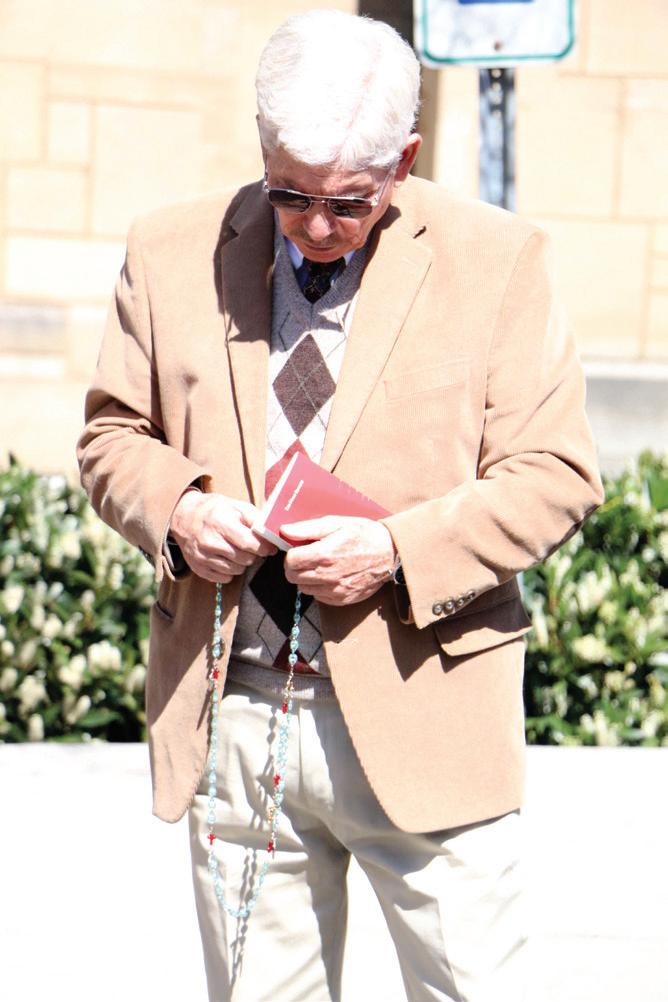
cated in writing and directly via Zoom meeting their mutual agreement of the transfer.
The decrees further established that Bishops Turazzi and Stika notified the Dicastery for Institutes of Consecrated Life and Societies of Apostolic Life at the Vatican of the transfer in accordance with the apostolic constitution Praedicate Evangelium
“This is truly a historic moment for the diocese. This is truly a historic day,” Bishop Stika said as he welcomed the Benedictines to the diocese.
Bishop Stika quipped that initial plans were to hold the ceremony on the site of the Benedictine orders’ monasteries in Blount County, but recent rains dampened that idea and would have left the only appropriate song to be sung as “Slip Slidin’ Away.”

“It was January that I traveled to Knoxville for the first time for a news conference announcing that I was the bishop. It’s been 14 years. I remember that the media asked what my priorities were. What was my goal? It was very simple, and it still is today. It is to teach Jesus. I also carry with me my episcopal motto, which is ‘Jesus, I trust in you,’” Bishop Stika recalled.
“I also said I would love to have a contemplative community in the diocese. A few years later, the Handmaids of the Precious Blood moved from New Mexico to here. Now, they’re blessed with three new vocations. So, they’re growing on a beautiful piece of property in New Market, Tenn. I then told the media I would welcome religious communities. We have the Religious Sisters of Mercy of Alma, Mich., and the Dominican Sisters of St. Cecilia Congregation in Nashville, and now I welcome two new communities. It’s the power of prayer. You can come up with new programs, new plans, new ideas to carry us into the future. But those are empty if you don’t have the power of prayer,” the bishop added.
“The Handmaids of the Precious Blood, their primary goal is to pray for priests. I think bringing into the diocese the spirituality of St. Benedict, work and prayer, is very important. So, Mother, it’s good to have you here. Father Elijah, it’s good to have you here. It is a blessing for the diocese. Cardinal Rigali, who is with us today, also rejoices with me in your presence. Thanks be to God that He truly is with us. And we take to heart those words from St. John Paul II, ‘be not afraid,’” the bishop concluded.
Deacon Smith explained that at 2 p.m. on Dec. 12, the Benedictines of Divine Will and the Benedictine Daughters of Divine Will were officially and canonically received into the Diocese of Knoxville.

A long journey
Mother Gabrielle Marie said, “Thank you for accepting us” as Bishop Stika signed the decrees. Then Father Elijah spoke about entering the Diocese of Knoxville.
“Thank you. We’ve been on a long journey. The journey, as you can imagine, has had the cross. When this started a long time ago now—Mother and I have been on this journey together for about 13 years—most people thought we were nuts to try to do this. People who understand the spiritual life told me that was a good sign. The craziest one of all is Jesus. He is the one who leaves the glory of the Father to come down and be with us on earth. This doesn’t make any sense except this is how things work when they’re genuinely of God.
“For whatever reason, we felt that God called us to Italy to do this. That was part of the calling. That made it more difficult because at the end of the day we had to rely more and more on God’s providence. The thing we learned more than anything is that God is utterly faithful. This today is a sign of His fidelity. It means a tremendous amount to us that we are
welcomed back into our country with joy and with enthusiasm and with hope,” Father Elijah said.
Father Elijah said he joked with Bishop Stika about how the Benedictines are leaving a diocese that was started 1,700 years ago and coming to a diocese that began a mere 34 years ago.
“Bishop Stika, with his great sense of humor, said, ‘Now you’re bragging.’ I wasn’t bragging; I was just telling it the way it is,” Father Elijah said laughing. “We’re an American community that is rooted in this ancient diocese, and now we’re coming back to this fresh, new diocese that is very American. It’s a new diocese that is building a cathedral, churches, and parishes. And that is exciting. Our prayer is that our presence here will truly be a blessing for the diocese. We ask for your prayers that our mission here can be successful. I think with the faithfulness of God and the faithfulness of Our Lady, we will be.”
Mother Gabrielle Marie echoed Father Elijah in gratitude to Bishop Stika and the Diocese of Knoxville.
“I just want to thank Bishop Stika for welcoming us, Cardinal Rigali, and our dear deacon (Sean Smith) for all your support and all of your help. You’ve been wonderful. And we just appreciate everything you’ve done for us. We hope we can be an asset to the diocese. We’ll try our best. God does it, and we just kind of ride along. We appreciate all of our friends being here and supporting us in every way. We hope we can give prayer support to the diocese. We’re willing to help in any way we can. Thank you. We’re so grateful that you opened your hearts to us. We’re just so happy to be here.
God bless you all and thank you,”
Mother Gabrielle Marie said.
According to their website,
osbdv.com , the Benedictines of Divine Will are born from and exist to love and serve Holy Mother Church. “We fully embrace the Second Vatican Council and seek to live in humble and loving filialobedience to his holiness, Pope Francis, his successors, and the College of Bishops. . . . Our community is Benedictine. Historically, the word ‘Benedictine’ has meant many different things. It has been used to describe strictly cloistered Camaldolese Benedictines, Missionary Benedictines, and Benedictines that excel in liturgical practice. The charism has also incorporated a wide range of spiritualities, among them: Franciscan, Carmelite, and Passionist.”
Divinely inspired beginnings
According to the Benedictine Daughters of Divine Will, the religious community is dedicated to living a life of prayer and work according to the Rule of St. Benedict, with eucharistic adoration and the Divine Will writings of Servant of God Luisa Piccarreta serving as the core of the order.
“We’re also devoted to the Sacred and Immaculate Hearts of Jesus and Mary, the chaste heart of glorious St. Joseph, and spiritual childhood, which altogether form the cornerstone of our growing family. It’s all very simple really. It’s life at Nazareth, and it’s all about love,” according to the community’s website.
“Outwardly, you won’t find anything particularly remarkable about our community. Though we try to put our whole heart and soul into everything that we do, God has not given us any great talents or abilities that would set us apart from, or even put us on par with, other religious groups. Our mission is much simpler and more hidden, yet no less demanding: to
live the Divine Will of God in love and charity like the Holy Family in Nazareth,” the website continues.
According to the Benedictine Daughters of Divine Will website, www.benedictinesofdivinewill. org , Mother Gabrielle Marie began her religious life as a Poor Clare of Perpetual Adoration. For 33 years, she learned much under the holy guidance of her late abbess, Mother Angelica, foundress of the Shrine of the Most Blessed Sacrament and EWTN (Eternal Word Television Network) in Alabama.
“Despite meeting many wellknown and even saintly religious figures through her monastery’s connection with the highly successful Catholic television network, the most significant moment in Mother Gabrielle Marie’s life came in 1998 through the hands of a young postulant under her care.
Through a simple request for permission to read a book given to the Sister by her grandmother, Mother Gabrielle Marie discovered, began reading, and instantly fell in love with the Divine Will writings of Servant of God Luisa Piccarreta,” the website states.
Father Elijah and Mother Gabrielle Marie felt the decree-signing on the feast of the patroness of the Americas was divinely inspired as was the original idea for the orders in 2009.
Mother Gabrielle Marie said she entered the convent in 1978 at age 33, where she served with the Poor Clares for 33 years.
In 2009, after nine years as vicar and 16 years as novice mistress with the Poor Clares, Mother Gabrielle Marie received a sabbatical. Needing some time to adjust to life away from the cloister, she decided to make a retreat at a Benedictine monastery with her longtime friend and spiritual director, Father Jacques Daley, OSB. Father Elijah happened to be at the same monastery at the same time.
After prayerful discernment with Father Daley and Father Elijah, a Benedictine also under Father Daley’s direction who was enamored with “little” Luisa Piccarreta’s works, the Holy Spirit placed something surprising on each of their hearts.
With Father Daley’s encouragement, Mother Gabrielle Marie and Father Elijah felt a clear call by God to start a new monastic community in Italy dedicated to eucharistic adoration and Luisa Piccarreta’s writings on how to live in God’s Most Holy and Divine Will. It was at this time that Mother Gabrielle Marie decided to leave the Poor Clares community.
Father Elijah was ordained into the priesthood in 2012, a year after Mother Gabrielle Marie founded the Benedictine Daughters.
Composed of brothers, sisters, and laity, the community would strive to unite the Benedictine spirit of prayer, work, and hospitality to the life of the Holy Family, turning their respective monasteries and homes into little Nazareths.
In 2011, the inspiration became a reality when Bishop Monsignor Luigi Negri accepted the Benedictine Daughters of Divine Will as a public association of the faithful in the Diocese of San Marino-Montefeltro. The Benedictine monks followed three years later under Bishop Monsignor Andrea Turazzi in the same diocese. And finally in 2016, the family was completed when Bishop Turazzi gave his permission and blessing to found

Luisa Piccarreta lives at the heart of the Benedictine family
Servant of God's life and Divine Will writings are a source of inspiration for the faithful
By Bill BrewerIn much of the world, Luisa Piccarreta is a saint in waiting whose prolific writings were divinely inspired and merit careful study.
To much of East Tennessee, the Servant of God is waiting to be discovered as her cause for sainthood makes its way through Vatican scrutiny.
As the Benedictines of Divine Will and the Benedictine Daughters of Divine Will introduce their “family”based charisms of Catholic faith to the Diocese of Knoxville, Luisa Piccarreta will be accompanying them in spirit and will undoubtedly inspire even more of the faithful than she has already.
Born in Corato, Italy, on April 23, 1865, Luisa, the “Little Daughter of the Divine Will,” was visited by suffering through much of her life. She had only a first-grade education, and as a teen she joined the Third Order of St. Dominic.
She began receiving revelations at age 12 and was called by God to become a victim soul, according to biographical information. By the time she reached age 24, she was bedridden with a condition doctors were unable to diagnose.
She is described as a Catholic mystic and author whose spirituality centered on the union with the Will of God.
In his book The Gift of Living in the Divine Will in the Writings of Luisa Piccarreta: An Inquiry into the Early Ecumenical Councils, and into Patristic, Scholastic, and Contemporary Theology, Father Joseph Iannuzzi writes that “at a very tender age, God spoke to her about a gift He wishes to bestow upon the world that will set it free and inaugurate an Era of World Peace.”
“God refers to this gift as ‘Living the Divine Will,’ for it is through an act of God’s Will that the earth will be made pure, and mankind will become holy,” Father Iannuzzi states.
“God revealed Himself to Luisa so that through her we may come
edictine Oblates of Divine Will.
I taly to East Tennessee
The Benedictine family established a male branch and a female branch. The male community is located in Carpegna, Italy, under the guidance of Father Elijah, while the sister community is located in Talamello, Italy, under the guidance of Mother Gabrielle Marie. The two contemplative families share the same charism and are located 40 minutes from each other, within the same diocese.
The Benedictines of Divine Will have begun the oblate program, with Bishop Turazzi giving his blessing to this lay branch of the religious community.
“All those who feel drawn to the Benedictines of Divine Will, yet not to the religious life, can now live our charism from outside of the monastery walls as oblates,” Father Elijah said.
The Benedictine family is now relocating to East Tennessee, where it will continue its ministry and charism. Mother Gabrielle Marie pointed out that the communities will still have a presence in Italy, where Italian and European members of the religious family will remain to further the ministry.
Through the generous assistance of benefactors, the Benedictines have acquired property in Blount County and have started construction on two monasteries, one for the men and one for the women. They also plan to build a church in between the two monasteries where Masses and other liturgical celebrations can be held.
“We have wanted to come back to the United States because most of our vocations for the women are from the United States. It’s been difficult. As they come, we have to get them religious visas, and they have to learn a new language and
to know the loving gift He has prepared for us,” the priest and author continued.
During her late teens, Luisa showed a mysterious and increasingly frequent state of suffering, with loss of consciousness and the subsequent experience of “petrifying,” during which she also had visions of Jesus choosing her as victim. The phenomena happened more frequently, which forced her to stay in bed.
It was discovered that a priestly blessing immediately freed her from the state of malaise, and a priest continued to do this whenever Luisa needed. Luisa eventually confided to a priest what happened when she lost consciousness, of her visions, and how she would be with Jesus when her soul left her body during unconsciousness.
She remained in bed, never leaving Corato, and lived solely on the Holy Eucharist and the Divine Will for the rest of her life, some 60 years.
It was during these years as a victim soul that a priest urged Luisa to write of her experiences with Jesus, which she did in the form of a spiritual diary, and from Feb. 28, 1899, to Dec. 28, 1938, she wrote about 10,000

get used to a new culture. So, we thought if we can come to the U.S., we can keep some of the community in Italy for all the European vocations, especially for the Italian vocations. You get more vocations here in the U.S. It's easier,” Sister Gabrielle Marie explained.

“We have friends who wanted us to come back. They helped us find a place. They helped us finance the place because we didn’t have any means to do that. We wanted to come to the U.S., but we didn’t have any money to buy property or build a monastery. So, the doors opened, and we said, ‘Why not go through them when the opportunity arises,’” she added.
She noted that the Blount County monastery will be the motherhouse for the Benedictine Daughters of Divine Will.
“We will not be based in Italy anymore. We will not be under the bishop in Italy anymore. We will remain in his diocese as a satellite house. The motherhouse will be here, so we’re really under the bishop of Knoxville, Tenn., now,” she said.
Father Elijah pointed out that for the Benedictines of Divine Will, the situation is similar.
“For us, it’s the same exact story. We started 13 years ago. We both were in religious communities. We both felt called to begin a new community called the Benedictines of Divine Will. They are the daughters. We are the brothers. We felt called to begin anew. We’re in the same diocese. There are several monasteries there. We’re very blessed with vocations. We have a very close relationship to our bishop of the diocese there. But it remains true that we’re both Americans, so it really makes a lot of sense for us, in the next phase of our community, to be on our home soil here.
“Bishop Stika was incredibly generous in welcoming us into the
pages that covered 36 volumes. Luisa died on March 4, 1947, from pneumonia. She was 81.
According to the Benedictine Daughters of Divine Will, the religious community is dedicated to living a life of prayer and work according to the Rule of St. Benedict, with eucharistic adoration and the Divine Will writings of Luisa Piccarreta serving as the core of the order.
“Luisa didn’t eat, sleep, or drink
Diocese of Knoxville. The two bishops were in contact. We did a Zoom call. We had to do all the translations, and Cardinal Rigali was present. Our bishop and Bishop Stika agreed that for our future this next step to the Diocese of Knoxville is the best thing for us,” Father Elijah said.
The Benedictine Daughters of Divine Will’s location in Talamello, Italy, is about five hours and 30 minutes north of Rome. The Benedictine monks of Divine Will are about a 40-minute drive from the Benedictine Daughters of Divine Will in Carpegna.
Another group of Benedictine Daughters live in San Marino, one of the smallest countries in the world, which is surrounded by Italy and is the oldest independent republic in the world.
Mother Gabrielle Marie expects six to seven Benedictine Sisters to relocate to the Diocese of Knoxville. According to Father Elijah, there will be about six Benedictine priests locating in the Blount County monastery. Each monastery will be able to house about 21 members.
Mother Gabrielle Marie is originally from Napoleonville, La., and Father Elijah is originally from Brooklyn, N.Y. Being closer to family is another positive aspect to the move.
“When we went to Italy, we had to get used to a new culture, a new language. The people are lovely there, and Italy is a beautiful country. The scenery is beautiful. But now we’re coming back. It was difficult to get adjusted to all of that, but now we love it. We’re getting adjusted to coming back to the U.S., but it will be easier because we were born and raised here. The American people are so friendly and so helpful. We’re really looking forward to it. We think it will be good, and we think we will get more vocations from it. We think
for 64 years. She lived on the Eucharist. Even though she had just a firstgrade education, she was like the secretary for Our Lord. He would give her these beautiful writings. He would teach her, and she would just write. They really are beautiful writings, very beautiful knowledge that transforms your life as it teaches you the love and mercy of God, how much He loves us, and He just wants us to return that love back to Him,” said Mother Gabrielle Marie Breaux, mother superior and foundress of the Benedictine Daughters of Divine Will.
“It focuses on all of that. The New Testament focuses on the humanity of Christ. This focuses on the divinity of Christ. We try to live the writings. Each Sister takes two hours of adoration a day to promote adoration,” Mother Gabrielle Marie added.
For the Benedictines of Divine Will, Luisa Piccarreta is just as important to the priests.
“The Benedictine life is a lot of adoration. We’re very eucharistic. We have this very strong devotion to Servant of God Luisa Piccarreta. The life of Nazareth is what we see as the model of the type of life we want to live,” said Father Elijah John Joseph of Our Lady of Guadalupe, who leads the Benedictines of Divine Will.
Luisa’s influence will continue to guide the Benedictines, even as they relocate their motherhouses from Italy near where Luisa lived to East Tennessee. Bishop Richard F. Stika has announced that the Benedictines of Divine Will and the Benedictine Daughters of Divine Will are becoming the newest religious communities to call the Diocese of Knoxville home.
Luisa’s life and devotion to Jesus and His Divine Will are at the heart of the Benedictines’ ministry.
“She had an incredibly miraculous, mystical life. She was incredibly devout as a young person. As a child, she was already so advanced
the community can flourish better here than if we remain in Italy,” Mother Gabrielle Marie said.
She noted that Blount County became a focal point for the orders because one of the Benedictine Sisters has a mother who had bought a house in Blount County, and she wanted to give that house to the Benedictine Daughters of Divine Will. They also had been given property in Georgia, but that property was difficult to build on.
“The Maryville house was only big enough to house four Sisters. It wasn’t enough. We need more than that if we’re going to grow. We could use that as a guest house maybe in the future. The benefactors then began looking for property around Maryville,” Mother Gabrielle Marie said, noting that the benefactors knew Father Elijah before they knew her.
She pointed out that the benefactors love the writings of Luisa Piccarreta, too.
“We just felt it was divine providence. There were all the signs, and we really discerned carefully what the will of the Lord was. And together it became very clear that all the signposts were pointing us towards Knoxville, so we take it for being divine providence, and we’re jumping in,” Father Elijah said.
The Benedictine monks and Benedictine Daughters are grateful to the benefactors who are supporting their ministry. They also are hoping for additional financial support from more donors who can assist them in their relocation to the Diocese of Knoxville as they look forward to completing their monastery projects and opening the church to serve them.
Any donations to the religious orders would be tax-exempt. Donors can contact the Diocese of Knoxville at dioknox.org or 865-584-3307 for more information on the Benedictine communities ■
Italian cardinal who was shroud custodian dies
By Carol Glatz Catholic News Service


Cardinal Severino Poletto, the retired archbishop of Turin and former papal custodian of the Shroud of Turin, died Dec. 17 at the age of 89.
Cardinal Poletto also was an active proponent of dialogue as an instrument to deal with challenges, such as Italy's debate about immigration and the massive crisis that hit one of Italy's largest car manufacturers, Fiat Automobiles S.p.A.
Pope Francis sent a telegram of condolence on Dec. 18 to Archbishop Roberto Repole of Turin, expressing his admiration for the cardinal, who spent his life being a "shepherd of the holy people of God" and dedicated to workers, families, and young people.
When appointed to the Archdiocese of Turin, the cardinal "wanted to devote himself without reserve to it, motivated by the desire to be close to his priests and to promote evangelization, including through major public events," the pope said
The cardinal oversaw numerous pastoral initiatives when the 2006 Winter Olympics took place in Turin, and he was in charge of public displays of the Shroud of Turin in 2000 and 2010, which attracted millions of visitors.
Cardinal Poletto was born March 18, 1933, in Salgareda, Italy.
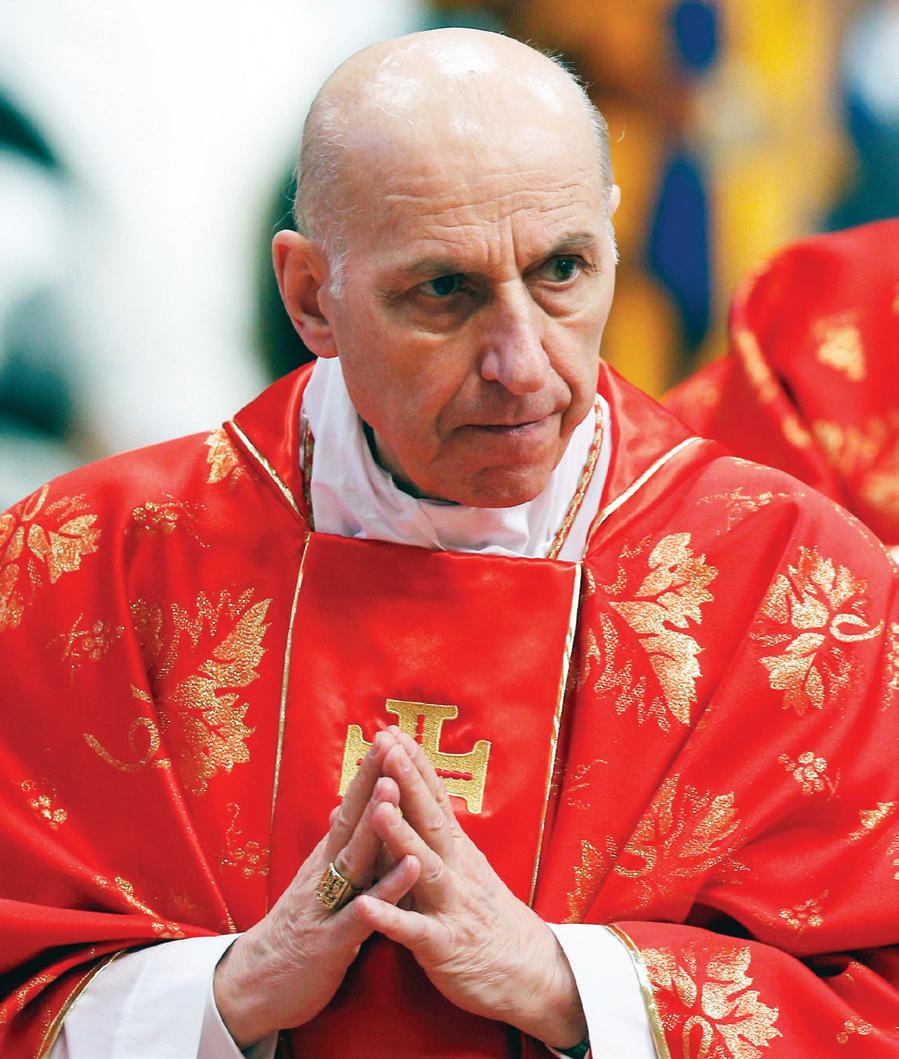
He earned a degree in moral theology from the Academy of St. Alphonsus in Rome and was ordained to the priesthood in 1957. He ministered in several parishes, was on the staff of the Casale seminary, and served as diocesan director of
vocations.
In early 1980, he was named coadjutor bishop of Fossano and became bishop of the diocese the following October. In 1989, St. John Paul II named him bishop of Asti, where he served 10 years, named him archbishop of Turin in 1999, and elevated him to the College of Cardinals in 2001.
In May 2001, Pope John Paul II named him a

member of the Congregation for the Clergy and the Prefecture for the Economic Affairs of the Holy See and the Pontifical Commission for the Cultural Heritage of the Church.
The cardinal retired in 2010 when Pope Benedict XVI accepted his resignation, which is standard among bishops, archbishops, and cardinals.
As archbishop of Turin, the cardinal was appointed custodian of the shroud, which many people believe is Christ's burial cloth.
The cardinal always referred to the shroud as an "icon," not a relic, and said it would be "irresponsible and dishonest" to claim it was authentic "because we do not have proof.''
Instead, he urged people to go beyond looking at its image of a crucified man to contemplating the reality of Christ's incarnation and death.


Cardinal Poletto's death leaves the College of Cardinals with 224 members, 126 who are under the age of 80 and eligible to vote in a conclave
Cardinal Poletto was the youngest of 11 children, nine of whom survived infancy.
The family emigrated to the Piedmont in northwest Italy in search of work in 1952. He studied at the seminary in Treviso and then at the major seminary in Casale Monferrato in the province of Alessandria. He was ordained a priest on June 29, 1957
After earning a licentiate in moral theology summa cum laude from the Alphonsian Academy in Rome in 1977, he worked as a curate in Montemagno. At one time while serving as a parish priest, he worked part-time in a local factory.
In 1973, he founded the Diocesan Centre for Family Ministry. ■
Funeral Mass held for diocesan Deacon Thomas Kiefer
Deacon Thomas J. Kiefer of Dayton died Nov. 23 at Erlanger Medical Center in Chattanooga after complications from multiple ailments. He was 85.


A funeral Mass for Deacon Kiefer was celebrated on Nov. 29 at St. Bridget Church, where he had served for years. Father Jim Vick, pastor of St. Bridget Parish, was the Mass celebrant. Interment was in Spring City at Spring City Memorial Gardens.

Deacon Kiefer, who was born in Louisville, Ky., on Sept. 7, 1937, had an early career in manufacturing with Oster/Sunbeam that took him away from his hometown of Louisville to
several small towns in Tennessee and Virginia.
He and his family moved to Dayton in 1968, where he was a founding member of St. Bridget Parish. He continued to serve as a deacon at St. Bridget into his retirement.
Deacon Kiefer also served as founding director of Rhea of Sunshine in Rhea County. In addition to his devotion to his family, he was devoted to service to others while at Rhea of Sunshine and other volunteer organizations.
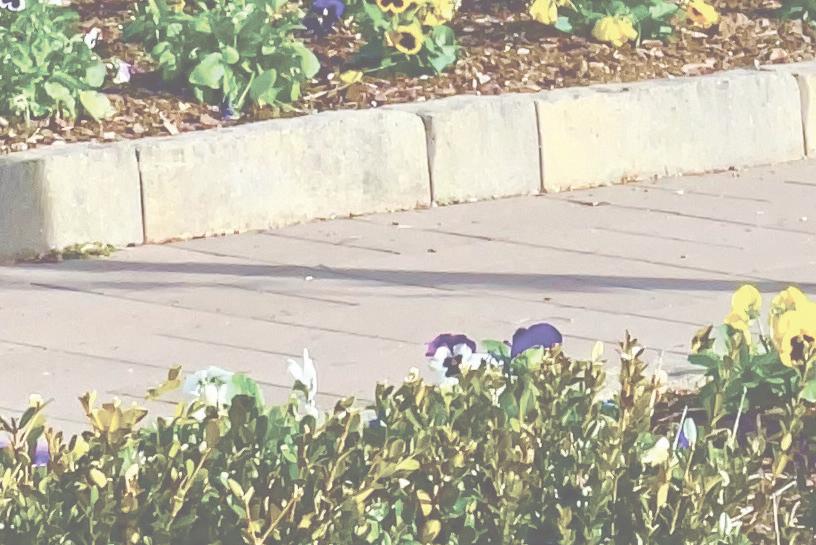




Deacon Kiefer is preceded in death by his par-

ents, Charles H. and Mary Elizabeth Kilcourse Kiefer; brother, Charles Kiefer; and wife, Mary Ann Kiefer.
Survivors include children David (Mitzi) Kiefer of Knoxville, Suzanne Kiefer of Dayton, and Christopher (Christine) Kiefer of Colorado Springs, Colo.; grandchildren, Michael Petro, Elyssa (Jesse) Robbins, Sarah (Nicholas) LeRay, Shauna Mackey, Phillip Kiefer, and Christopher Kiefer. Donations in Deacon Kiefer's memory may be made to St. Bridget Church, P.O. Box 106, Dayton, TN 37321 and the Animal Shelter Alliance of Rhea County, 9118 Back Valley Road, Evensville, TN 37332. ■
Pope Francis marks 86th birthday with kids clinic party
 By Catholic News Service
By Catholic News Service
Pope Francis spent part of his 86th birthday on Dec. 17 paying tribute to people who have gone above and beyond in the exercise of charity.
At a Dec. 17 ceremony in the Vatican, the pope presented the Mother Teresa Prize to: Franciscan Father Hanna Jallouf for his service to the poor of Syria; Gian Piero, also known as Wué, a homeless man who gives a portion of the alms he receives to people who are poorer than he is; and Silvano Pedrollo, an Italian businessman who builds schools, wells, and health clinics in India, Africa, and Latin America.
The award was sponsored by the Dicastery for the Service of Charity to honor people who, like St. Teresa of Kolkata, dedicate their lives to serving the poorest of the poor.
Two dozen members of the Missionaries of Charity and 20 guests housed in one of their Rome shelters joined Pope Francis and the award winners for the audience.
And soon after the ceremony, the Vatican press office announced that Cardinal Konrad Krajewski, head of the dicastery, had set off again for Ukraine with a truckload of generators, thermal clothing, and other donations for the victims of war.
Pope Francis thanked his guests, including the cardinal, for their affection and for their witness to fraternity and the need for prayer, "which is the legacy that Mother Teresa always gave us. Even prayer in dark times—because
Happy Birthday!
Pope Francis receives a cake for his 86th birthday during an audience with children and volunteers of the Vatican's St. Martha Dispensary, a maternal and pediatric clinic, at the Vatican on Dec. 18.

During his birthday party, the Holy Father and his young guests were entertained by circus performers.

have been biological children,” he continued. “So, I would say that, to me, was probably the most spiritual aspect of going through is that full acceptance and being able to accept somebody as just exactly who they were and love them unconditionally. They’re our children.”
‘Be open’
The Krepps have words of wisdom to share from their own experiences with adoption.
“For those into the journey already, I think it’s very important to be open to everything,” Mrs. Krepps said. “Be open to pray and hear what God is calling them to do because there are God’s children everywhere that truly need to be adopted and have a forever home.”
She noted that the road to adopting a child is not always easy, noting that once they lost a child they thought they were going to adopt.
“John was in the service at the
this woman went through real spiritual storms with darkness inside, but she kept praying. She was a brave one!"
The pope prayed that "Mother Teresa from heaven" would help Christians to live "with simplicity and prayer."
The day after he turned 86, Pope Francis met with volunteers, family members, and children receiving care from a Vatican pediatric clinic.
The group of children receiving assistance from the Vatican’s St. Martha Dispensary, a maternal and pediatric clinic, were treated to a show by circus performers in the Vatican’s Paul VI hall and to a large white sheet cake adorned with one tall candle.
The pope thanked his guests for their visit and for a “day of joy that helps us prepare for Christmas.”

He also reminded everyone to not forget to pray for the children of Ukraine—“so many children who suffer because of war, and they suffer also in other places because of injustice.”
In other news from the Vatican, Pope Francis said he wrote a resignation letter in 2013, his first year in office, to be used in case he became physically or mentally impaired and unable to fulfill the duties of the papacy.
In an interview published Dec. 18, Pope Francis said that during the time that Cardinal Tarcisio Bertone was Vatican secretary of state, a position he left in October 2013, he gave a resignation letter to the cardinal.
"I signed it and said, 'If I should become im -
paired for medical reasons or whatever, here is my renunciation. Here you have it,'" the pope told the Spanish newspaper ABC
Pope Francis joked that now that the letter's existence has been made public, someone will go after Cardinal Bertone and say, "Give me that piece of paper!"
But he also said he was certain Cardinal Bertone gave it to Cardinal Pietro Parolin, who succeeded him as secretary of state.
The interviewer also noted that Pope Francis had named several women as secretaries or undersecretaries of Vatican offices, but that he had not appointed a woman to lead a Vatican dicastery, although his reform of the Roman Curia says it is possible for a layperson to head a dicastery.
Pope Francis responded that he has been thinking of appointing a woman to lead "a dicastery where there will be a vacancy in two years." He did not say what office that was.
"There is nothing to prevent a woman from guiding a dicastery in which a layperson can be a prefect," the pope said.
However, "if it is dicastery of a sacramental nature," presumably like the dicasteries for the Doctrine of the Faith, for Bishops, for Clergy, or for Divine Worship and the Discipline of the Sacraments, "it has to be presided over by a priest or a bishop," the pope said.
Asked if he worries about active Catholics who may feel neglected by the pope paying so much attention to people who feel far from the Church, Pope Francis responded, "If they are good, they will not feel neglected." ■
time; they just felt the child needed to stay in that state. That was very hard because we had that baby for what, two weeks, before they told us that was going to happen,” Mrs. Krepps recalled.
Another possibility is the birth mother may change her mind at the last moment.
“I’ve heard of cases like that, and that’s very hard,” Mrs. Krepps said.
“But again, being open to knowing that anything can happen I think is the most important thing when you’re in the midst of it.”
She also advises to open up to family and friends about being “pregnant.”
“It might take a year, but you’re expecting and not to be afraid to feel that way,” Mrs. Krepps said.
“Many people are afraid to open up and share because somebody might fall through… but as long as you keep it under the Lord… it will come together, and God will bless that.”
Deacon Krepps noted that “a lot of doors were opened because a lot of our family and friends knew we wanted to adopt,” and he encourages anyone thinking about adopting to inform any lawyers, case workers, or nurses that they know.
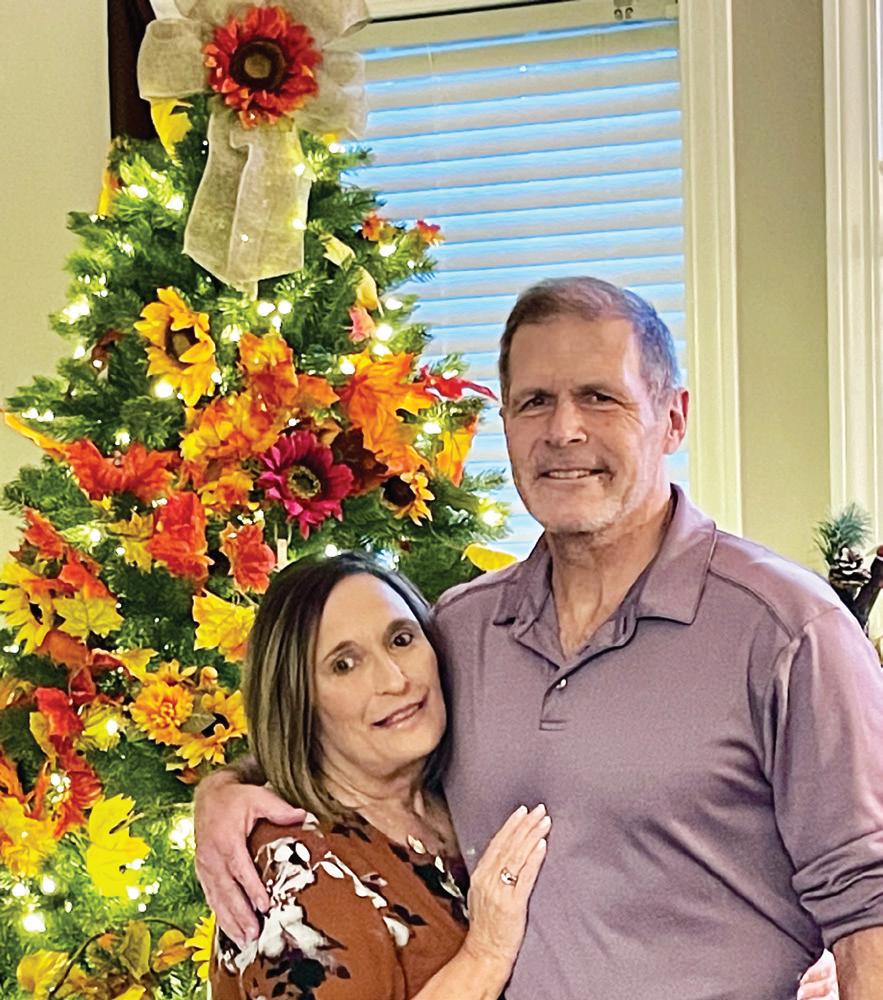
Deacon Krepps remembered many people telling him the average time to wait for your first adoption was three to five years.
“Many people shared this with us while we were still waiting for our first child,” he said. “They emphatically said don’t get discouraged, and then they said what’s going to happen after your first adoption, the floodgates will open and seems like a lot more opportunities will avail themselves.”
“And that’s exactly what happened to us, as well,” he continued. “So, spend that three to five years doing what you can… helping out other families with their children.”
Deacon Krepps noted that with
their adoptions the lawyer fee to enact the paperwork was the biggest expense.
“As adoptions are concerned, you don’t need to have a lot of money, and I don’t think a lot of people realize that, especially if you don’t go through an agency,” he said. “All of our adoptions were private adoptions except one.”
“We didn’t have the opportunity to consider Catholic adoption agencies at that time. So, I’m very excited that that’s opening up here in the Knoxville area,” Mrs. Krepps added, referring to Catholic Charities’ Adoption Services program.

Catholic Charities of East Tennessee now offers adoption through its Adoption Services program, which went into full operation in 2022.
“I’m very excited about that because more people have an opportunity to adopt that have not been able to in the past,” she said. “I believe that it is a calling from the Lord, and it’s a vocation.” ■
‘A whirlwind romance’
Left: John and Theresa Krepps have been married 39 years and have five adopted children.The
fourth adoption Right: the Krepps family welcomes baby Emily into the family in January 2000.COURTESY OF DEACON JOHN AND THERESA KREPPS COURTESY OF DEACON JOHN AND THERESA KREPPS Catholic News Service photos by Guglielmo Mangiapane, Reuters














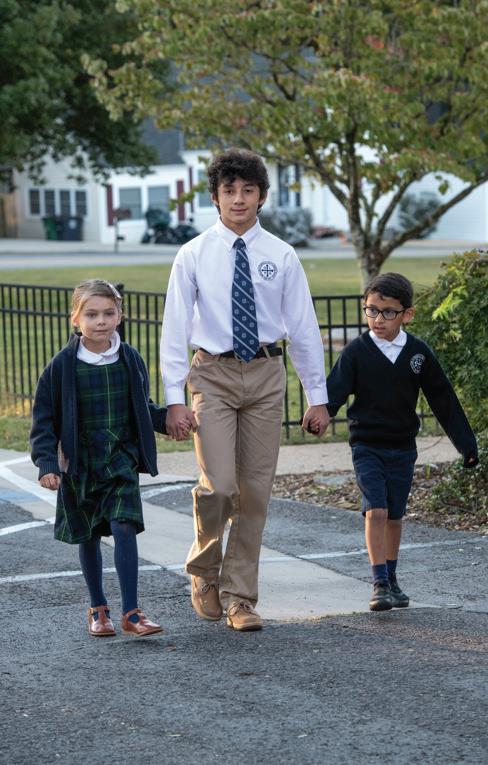
siastic, and joyful person. I still carry lessons I learned from him to this very day. Now that I am a teacher in the diocese, I am even more grateful for the training and mentorship I received from Father Augustine,” Mr. Tortora said.
Not long after his move to Notre Dame High School in 2012, Father Idra was asked to serve his religious community as the regional superior, overseeing all of the priests of the Apostles of Jesus in the United States.
He humbly accepted with the blessing of Bishop Stika and moved from East Tennessee to Pennsylvania.
“My priestly ministry in Knoxville meant a world to me,” recounted Father Idra. “Despite my cultural shock, I was warmly welcomed by the bishop, the clergy, and laity quickly, which made my adjustments easy to the new environment. I truly enjoyed my stay in Knoxville up to the point that I never wanted to move away, but then as a missionary I have no choice but to accept the will of God and move to serve my community as a leader in the present position.”
Upon his approaching silver jubilee, members of St. Jude parish knew they wanted to invite their beloved priest back to his first assignment in the United States to celebrate. With a little convincing, Father Idra humbly accepted the invitation.
“I want to express my gratitude to Father Charlie and the parishioners of St. Jude who allowed me to come home and say thank you to God and to all of you for taking good care of me so many years ago.
in the spiritual life,” Father Elijah said. “When she was 18 years old, Jesus basically put her in bed, where she lived 60 years confined to her bed. The doctors never could explain it. In fact, every morning in order for her to wake up, she had to have a priest come and give her a blessing. Jesus explained that He wanted her always to be dependent upon His priests and upon His Church. Incredible suffering.”
And Luisa’s interpretation of Divine Will and its relationship to Divine Mercy is unmistakable to Mother Gabrielle Marie.
“She had mystical experiences as a child,” Mother Gabrielle Marie said. “The thing is, Luisa was born on the Sunday after Easter, which is now Divine Mercy Sunday. She also made her first Communion and confirmation on Divine Mercy Sunday. She would go into this experience where her soul would leave her body. She would get like comatose. The Vatican gave permission for Mass to be said in her bedroom every day. The priest would come and call her out of this state. Only the priest could do it. He would say, ‘Holy God, mighty God, Holy Immortal One, have mercy on us and the whole world. He would say that three times, which is the Divine Mercy prayer on the Chaplet. That didn’t exist then as the Divine Mercy prayer. How the Divine Mercy and the Divine Will are so close to each other.”
“It’s interesting because Bishop Stika has such a tremendous devotion to the Divine Mercy, so we feel very connected to him,” Father Elijah noted.
Mother Gabrielle Marie pointed out that the Vatican has published a book, The Sun of My Will, a biography of Luisa.
“There are many people in the world who are working on this cause,” Father Elijah said about the possible canonization of Luisa Piccarreta.
Another miraculous attribute of Luisa was her invisible stigmata, which was sometimes seen by the person looking after her, according to Mother Gabrielle Marie, who noted that Padre Pio would send people to Luisa.
“She suffered terribly. She was a victim soul,” Mother Gabrielle Marie said. A victim soul is an individual who has been chosen by God to un-
dergo physical and sometimes spiritual suffering beyond that of normal human experience.
She was declared a Servant of God in 1994, and her cause for sainthood continues.
Mother Gabrielle Marie said the Vatican has recognized and approved Luisa’s Divine Will writings and is trying to establish good translations of the writings.
“We feel we have a good English translation. It’s not complicated. It’s deep. So, because of that there are some things the Church wants to qualify, to understand, and to help people understand it and make it clear what Our Lord is really teaching us through these writings,” she said.
Among those who have studied Luisa Piccarreta’s Divine Will writings and are keenly interested in advancing them to the Catholic faithful is Paul Simoneau, vice chancellor of the Diocese of Knoxville and director of the diocesan Office of Justice and Peace
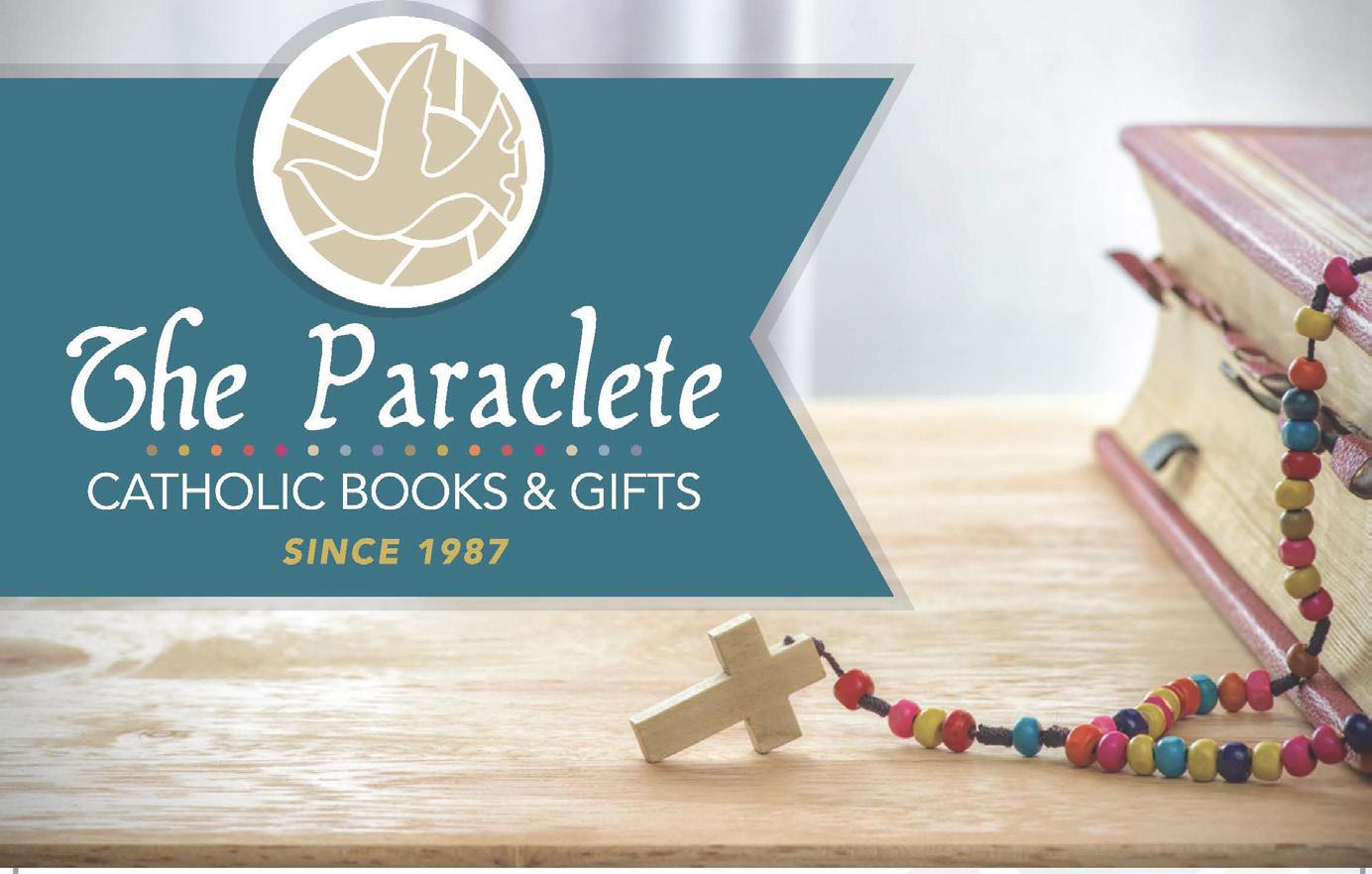

Mr. Simoneau has been closely reading the Divine Will writings for decades and is excited that the Benedictines of Divine Will and the Benedictine Daughters of Divine Will will be bringing Luisa’s divinely inspired words and life story with them as they relocate from Italy to the Diocese of Knoxville.
“Since 1993, when I was first introduced to the mystical life and writings of the Servant of God Luisa Piccarreta, I have longed for the day when a religious community, anchored in the Church and faithful to her infallible teachings like that of the Benedictines, would become a beacon of light for the ‘kingdom of the Divine Will,’ which Jesus taught us to pray for—'Thy kingdom come, Thy Will be done on earth as it is in heaven,’” Mr. Simoneau said.
Mr. Simoneau’s interest in Luisa goes beyond a casual introduction into her spiritual life.
“Having had the great blessing and very small part of proofing the most accurate English translations of Luisa’s writings and operating her website in nine languages over past years, I rejoice to see the light of this great gift that will have a mountaintop place within our diocese and country to brightly shine,” Mr. Simoneau noted.
For Mother Gabrielle Marie and Father Elijah, there is little doubt about Luisa's saintliness.
“God
“There are thousands and thousands of pages of mystical writings. The cause of Luisa, it’s very clear she was a saint. Her virtues, her faith, her love are exceptional. The bishops of the diocese where she is from say that openly. There is no question she is a saint, but the cause is moving forward in union with the writings. They usually don’t do that. Usually they separate the two, but because these writings are very significant, the Church, with its prudence and wisdom, is taking its time to understand what happened to this remarkable soul, who died, according to the Church’s time frame, not that long ago,” Father Elijah said.
Mother Gabrielle Marie was inspired by Luisa’s Divine Will writings when she was introduced to them in 1998.
“I just fell in love with it right away. This is what I had been looking for, but I didn’t know this was possible,” she said. “In all the years I was growing up, I used to ask God to take my will away and to give me
by Father Carter during his homily, a common phrase coming from Father Idra at the pulpit.
Father Carter compared Father Idra to the great saints from whom he finds inspiration and whose lives he imitates. Mentioned were the faithful discipleship of St. Augustine; jolly and generous St. Nicholas; St. Jude, the patron of impossible causes; and the holy and grace-filled Mother Mary.
Father Carter also remembered Father Idra’s deep love of soccer, specifically Manchester United in England, and Father Idra’s unique style choices, especially wearing scarves and jackets in the heat of summer.
“He’s the first person I ever met who wore a scarf in the summer,” Father Carter said. “In fact, even in the summertime here in the U.S., some have speculated that he wears more layers than you can see. During the winter, it would be no surprise if he had on even more layers than an onion.”
As a token of gratitude, Deacon Gaspar DeGaetano, who serves at the Basilica of Sts. Peter and Paul, presented Father Idra with two chalices on behalf of members of the Knights of Columbus to be used by the Apostles of Jesus.
“My anniversary celebration was a typical lovely and genuine support of the people of the Knoxville Diocese for me,” Father Idra said.
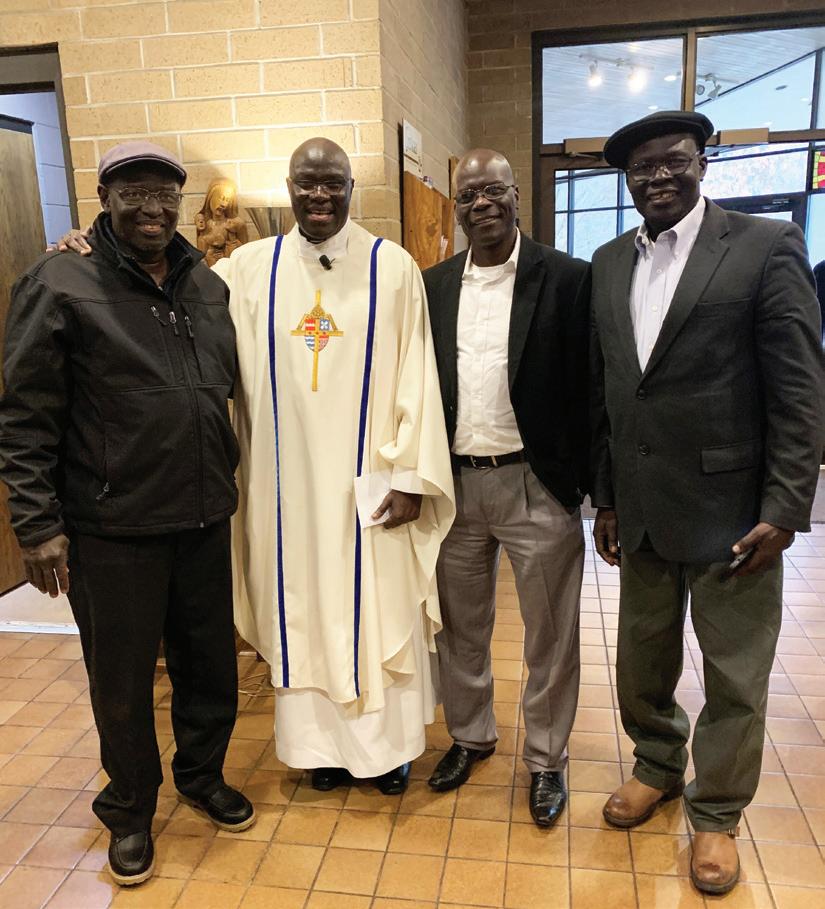
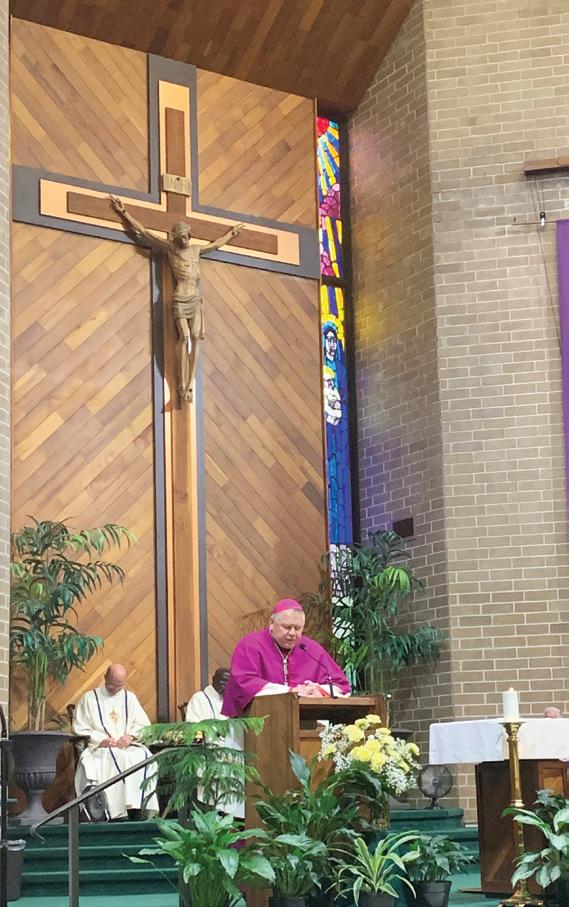
“I was overwhelmed and humbled. I don’t deserve it but, again, I humbly accept God’s will for me.”
Father Idra’s fellow priests and the parishioners he served shared a common sentiment: beloved and missed, Father Augustine Idra always has a home in the Diocese of Knoxville. ■

His Will, which He doesn’t do because your human will is a gift. But His Will and your will are meant to become one. That’s what the Divine Will is all about: your will and His Will becoming one,” she said. “So, I feel because I prayed that as a child, Our Lord presented me with these volumes.”
The Vatican placed the original volumes of Luisa’s Divine Will writings in its archives for safekeeping and study, and Mother Gabrielle Marie said Pope Benedict allowed several people to make copies for the bishop of Corato in the 1990s.
Father Elijah said, like with St. Faustina, the Church went through a period of questioning when it wasn’t certain that what had occurred with Luisa was God’s providence.
“But then it became very clear in the 1990s,” Father Elijah said. “It’s now in many places in America.”
“It’s growing fast. Groups everywhere are interested in it. It’s getting to be known more and more,” Mother Gabrielle Marie concluded. ■
Incivility is on the rise, but what do we do about it?
By Julie Asher Catholic News ServiceRudeness is on the rise. You got a problem with that?” screams a recent New York Times headline.
“How rude behavior is becoming the new normal In America,” declares a LinkedIn article. Yet another headline, this one from Fortune, proclaims: “It’s not just you, people really are being more rude lately.”
Throw in what a majority of Americans polled on the topic say, that the “tone and civility of U.S. political debate” has been worsening for some time, and it’s not a pretty picture.
So why is this the case, why should it matter, and what can be done about it?
Enter Georgetown professor Christine Porath with data and some solutions. She has been studying incivility, particularly in the workplace, for a good 20 years.
“Incivility is like a virus you can catch anywhere — online, at work, in families, in our communities,” Ms. Porath told Catholic News Service in a Dec. 13 interview. “We can see that people pass it on to others even when they’re not aware of it and may not mean to demean others.”
It can be spread simply by someone “who is on edge and just took in a lot of negativity” and turns around and shouts at someone else, she said. “This kind of disrespect, rudeness spreads. This is why our small actions matter so much.”
A tenured professor at Georgetown University’s McDonough School of Business, she is a book author and a frequent contributor to the Harvard Business Review. She also has written articles for The New York Times, The Wall Street Journal, McKinsey Quarterly, and The Washington Post
She does research and conducts surveys, sometimes in partnership with others, to gauge incivility, particularly in the workplace.
But what happens at work or a place of business has a ripple effect beyond the office walls, she noted In a Nov. 9 article in the Harvard Business Review, she presented results of a new survey she conducted in August to “further track incivility trends and glean more insight into what’s happening on the frontlines of business and society today.”
“Regardless of how individuals define incivility, they’re reporting more of it — and have been for a while now,” Ms. Porath wrote. “In 2005, nearly half of the workers I surveyed across the globe said they were treated rudely at work at least once a month. In 2011, it was up to 55 percent, and by 2016 it had climbed to 62 percent.”
For her new survey she gathered data “from more than 2,000 people in more than 25 industries in various roles across the globe. … They included both frontline employees and people who had observed them at work.” Seventy-six percent of
done."
Charter continued from page A10
American problem. And then it was suggested that it was an Englishspeaking problem," he said.
"Well, now it doesn't just speak English. It speaks Polish, it speaks German, it speaks Spanish," he said, referring to abuse crises that have emerged in other countries.
"The world has come to a much clearer awareness that this is an issue that has touched the Church globally. Praise be God, Pope Francis has taken a much more direct, active and, I hope, effective response to these issues," Cardinal Gregory added.
The U.S. bishops have revised the original charter three times since its adoption in 2005, 2011, and 2018.
In 2019, Pope Francis issued the motu proprio Vos Estis Lux Mundi ("You are the light of the world"), which revises and clarifies norms and procedures for holding bishops and religious superiors accountable for protecting abusers worldwide.
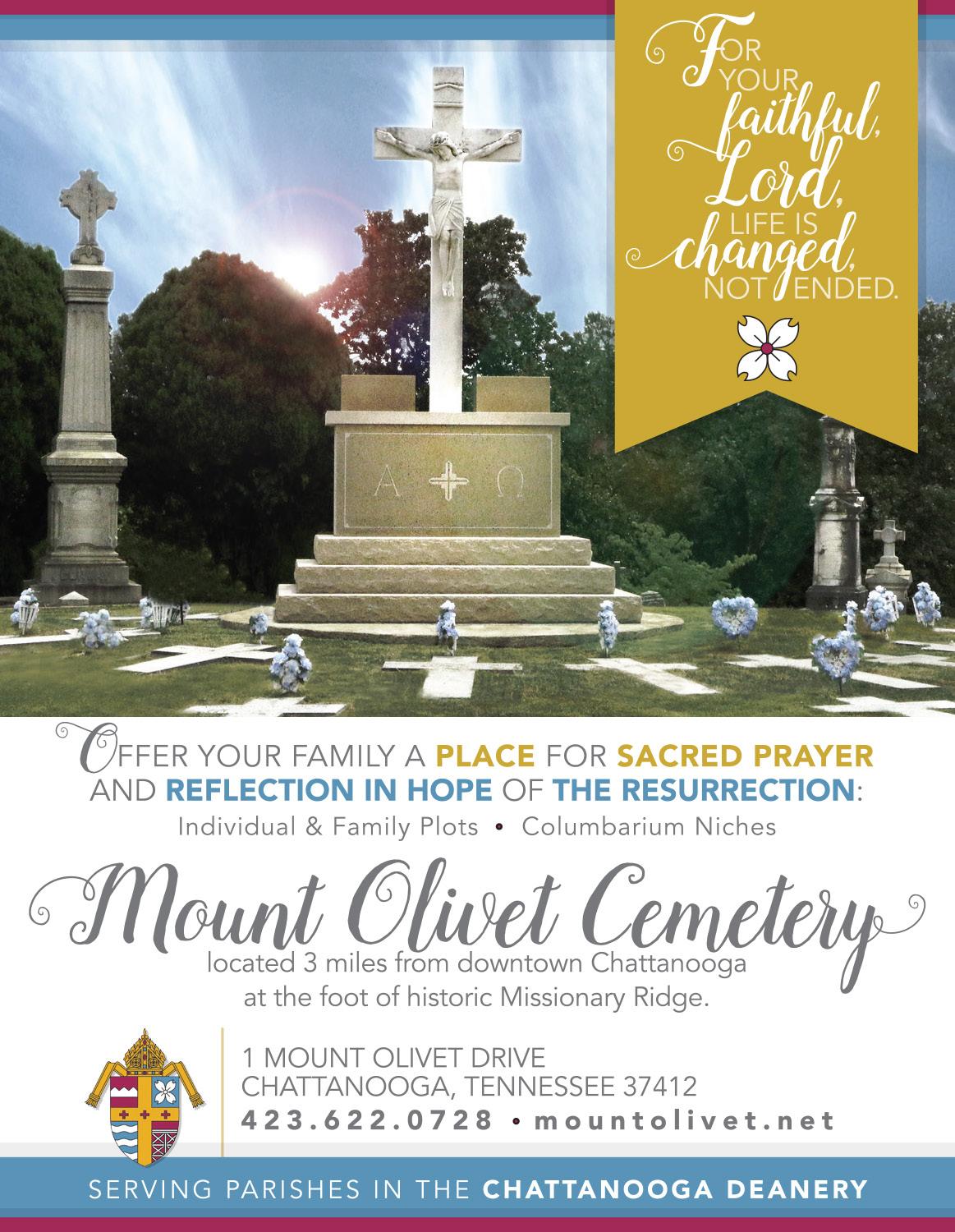
At a June meeting that year, the U.S. bishops passed three new bishop accountability reforms, and they establish a third-party reporting system for allegations of violations by bishops.
The abuse crisis has few, if any, winners. Survivors may feel cheered at having their story acknowledged and believed, but it hardly wipes away the original abuse.
"We have suffered serious loss of credibility" as bishops, Cardinal Gregory told Catholic News Service. "We have many wonderfully generous, honest, open, transparent, and believable bishops. But it only takes one or two to undermine all of the hard work they have
A lesson in civility A woman in Kenosha, Wis., hands flowers to a member of the Wisconsin National Guard in this Aug. 28, 2020, photo. Civility experts say small gestures of kindness can help turn around the growing trend of incivility in society.

respondents said they “experience incivility at least once a month,” she reported
In addition, she wrote, 78 percent said they “witness incivility at work at least once a month, and 70 percent witness it at least two to three times a month”; 78 percent “believe that bad behavior from customers toward employees is more common than it was five years ago”; and “66 percent believe bad behavior from customers toward other customers is more common than it was five years ago. ”
These 2022 numbers, she noted, “have risen steadily and sharply” since a 2012 survey she did.
“Sadly we have seen a real trend rise in incivility and disrespect over the years,” Ms. Porath told Catholic News Service.
“Why should it matter? … Because it has a terrible effect on people,” she said.
In the workplace, it can affect people’s work performance, Ms. Porath noted. “Whether they are the object of disrespect or rudeness” or they witness others treated like that, “they are far less attentive” to their work.
But “the good news is we find civility spreads. So what can we do?” she said. “It’s very simple. … The little things we do — smile, say hello, put away our phone, and pay attention and ask, ‘How can I help?’ These little things make a difference.”
People do not have a sense of belonging today, and mental health issues are a huge problem, Ms. Porath pointed out.
“Suicide is at an all-time high. We don’t know exactly who is hurting, (but) we can often sense who doesn’t feel part of the community. Can we look out and care for them in small neighborly ways?” she asked.
One of Ms. Porath’s favorite people who models how we can help lift up people is Pope Francis and “all the wonderful things he has spent a lifetime doing.”
The pope just addressed this in written remarks distributed to members of the boys’ and girls’ section of Italian Catholic Action, a parish-based pro-
"I think one thing that was really great this past year was the information that came forward from all these governmental reports" such as Germany, France, and England, said Zach Hiner, executive director of the Survivors Network of Those Abused by Priests.
"I think it's a good sign that governments across the world [say] that stopping sexual abuse is something they have to be involved in, and not shunting off the burdens to the institution," he told Catholic News Service.
Despite SNAP's reputation as a confrontational organization, "Church officials want to work with SNAP," but most survivors come to SNAP because it is independent, Mr. Hiner said. "Most of our members want that arm's length relationship."
"The Church will always have to be dealing with issues of abuse in general. The charter from 20 years ago opened a door for folks to be able to address and bring up their memories," said Deacon Bernie Nojadera, now in his 12th year as executive director of the bishops' Secretariat for Child and Youth Protection.
Regarding the strain on diocesan operations and budgets due to abuse payouts, Deacon Nojadera said, "I've had bishops report to me, tell me that because of the economy, because of monetary shortcomings, bankruptcy, they tell me they've had to shut down ministries."
"But they tell me their ministry for protection is going to be the last ministry to be shut down," he added.
Deacon Nojadera said he is "eternally grateful for the survivorvictims telling their story and mak-
gram of faith building and social outreach, during an audience at the Vatican Dec. 15.
He encouraged youngsters to put down their phones to spend time praying and looking at other people to see their needs. “God does not like it when we get lazy on the couch; he wants us on the move, on the road, ready and willing to get involved,” he wrote.
Pope Francis’ words and teachings — particularly the third encyclical of his papacy, Fratelli Tutti, on Fraternity and Social Friendship” — inspired the U.S. bishops in September 2021 to launch their own initiative called “Civilize It” to address polarization across society and bring people together to serve the common good, much like what Ms. Porath advocates.
A special webpage for the initiative, CivilizeIt. org, has links to a toolkit with resources to help parishes, small groups, and individuals address polarization of any kind.
Website visitors are invited to sign a pledge saying they will rely on “charity, clarity, and creativity” to promote understanding and dialogue over division. Signers pledge to affirm each person’s dignity, even when they disagree with someone, and respectfully listen to others “to understand experiences different from my own.”
Ms. Porath, who is Catholic, credited her Jesuit college education for the professional path she has taken, calling it “fundamental to who I am and what I study for sure.” She earned her bachelor’s degree at the College of the Holy Cross in Worcester, Mass. She has a doctorate from the University of North Carolina at Chapel Hill.
Once she was in the workplace, she discovered she “had a hunger” for ways “we can study things and make a difference, too.” She said her Catholic high school instilled in her a desire to help others.
Besides the dozens of articles she has written and her many speaking engagements, she also has penned a number of books about the workplace and civility aimed at business leaders because it’s important to get the word “out there to people who can do something” to change the work culture
She said she always pairs data “with stories of people that provide a path forward and why this makes a difference,” as she did in her wellreceived 2017 book, Mastering Civility: A Manifesto for the Workplace
Among people in business she looks to for inspiration and has written about are Amy D’Ambra, a good friend she calls her “hero,” and her own brother, Mike.
Ms. D’Ambra is the founder and president of Los Angeles-based My Saint My Hero, which creates “wearable blessings” — jewelry made “with love and prayer,” as the website says. The company, through its sales, helps women in need around the globe, including survivors of human trafficking. ■
ing their reports. That's the saving grace. They brought to the light what was in the dark. And thank God for the Boston Globe and that movie 'Spotlight' and any other opportunity for survivors to feel strengthened."
The deacon said, "It's bad the abuse took place. I have every sorrow and apology; that hurts to the core ... to have to hold that in silence out of fear or perhaps thinking they may be the only one."
"The miracle of that Boston Globe headline is for those survivors who think they were alone, (it) gave power, gave strength to all those other survivors who thought they were alone," he said.
Today, he added, "every diocese in the United States has a victim's assistance office and safe environment coordinator, and a consistent, reliable relationship with law enforcement officials as well as elected officials." ■
